#chicago independent radio project
Explore tagged Tumblr posts
Text
Rudy G presents: Undefined
Some dark vibes, with some positive flow and lyrics. Perfect combination

“Undefined” is a philosophical take on identity and perseverance. The track tackles the struggles of navigating a chaotic world while staying true to oneself. Listen the single in Spotify:
Rudy G is an independent hip hop artist and beat maker from Illinois. As a hip hop artist, he has released several independent projects including his debut album "High Society" and his “Generally Speakin” mixtape series.
His music has been featured on several nationally distributed mixtapes, blogs, streaming services and radio stations. He has performed at several live venues in the Chicago-area including the historic Abbey Pub. Rudy G was also the recipient of the ‘Art in Your Ear Award’ which recognizes local artists for their songwriting abilities. During his time, he has collaborated with several rappers, various producers, and other artists outside of the hip hop/rap genre. As a beat maker, he was featured on the new X102.3’s "Local Love Show" and also on DJ Chuck T's "Lyrical Exercise Volume 4".
3 notes
·
View notes
Text
Events 2.23 (before 1940)
303 – Roman emperor Diocletian orders the destruction of the Christian church in Nicomedia, beginning eight years of Diocletianic Persecution. 532 – Byzantine emperor Justinian I lays the foundation stone of a new Orthodox Christian basilica in Constantinople – the Hagia Sophia. 628 – Khosrow II, last Sasanian shah of Iran, is overthrown. 705 – Empress Wu Zetian abdicates the throne, restoring the Tang dynasty. 1455 – Traditionally the date of publication of the Gutenberg Bible, the first Western book printed with movable type. 1725 – J. S. Bach leads his Tafel-Music Shepherd Cantata for the birthday of Christian, Duke of Saxe-Weissenfels. 1763 – Berbice slave uprising in Guyana: The first major slave revolt in South America. 1778 – American Revolutionary War: Baron von Steuben arrives at Valley Forge, Pennsylvania, to help train the Continental Army. 1820 – Cato Street Conspiracy: A plot to murder all the British cabinet ministers is exposed and the conspirators arrested. 1836 – Texas Revolution: The Siege of the Alamo (prelude to the Battle of the Alamo) begins in San Antonio, Texas. 1847 – Mexican–American War: Battle of Buena Vista: In Mexico, American troops under future president General Zachary Taylor defeat Mexican General Antonio López de Santa Anna. 1854 – The official independence of the Orange Free State, South Africa is declared. 1861 – President-elect Abraham Lincoln arrives secretly in Washington, D.C., after the thwarting of an alleged assassination plot in Baltimore, Maryland. 1870 – Reconstruction Era: Post-U.S. Civil War military control of Mississippi ends and it is readmitted to the Union. 1883 – Alabama becomes the first U.S. state to enact an anti-trust law. 1885 – Sino-French War: French Army gains an important victory in the Battle of Đồng Đăng in the Tonkin region of Vietnam. 1886 – Charles Martin Hall produced the first samples of aluminium from the electrolysis of aluminium oxide, after several years of intensive work. He was assisted in this project by his older sister, Julia Brainerd Hall. 1887 – The French Riviera is hit by a large earthquake, killing around 2,000. 1898 – Émile Zola is imprisoned in France after writing J'Accuse…!, a letter accusing the French government of antisemitism and wrongfully imprisoning Captain Alfred Dreyfus. 1900 – Second Boer War: During the Battle of the Tugela Heights, the first British attempt to take Hart's Hill fails. 1903 – Cuba leases Guantánamo Bay to the United States "in perpetuity". 1905 – Chicago attorney Paul Harris and three other businessmen meet for lunch to form the Rotary Club, the world's first service club. 1909 – The AEA Silver Dart makes the first powered flight in Canada and the British Empire. 1917 – First demonstrations in Saint Petersburg, Russia. The beginning of the February Revolution (March 8 in the Gregorian calendar). 1927 – U.S. President Calvin Coolidge signs a bill by Congress establishing the Federal Radio Commission (later replaced by the Federal Communications Commission) which was to regulate the use of radio frequencies in the United States. 1927 – German theoretical physicist Werner Heisenberg writes a letter to fellow physicist Wolfgang Pauli, in which he describes his uncertainty principle for the first time. 1934 – Leopold III becomes King of Belgium.
0 notes
Text


Name: Leopold Weiss
Age & Birthday: 71 years old, April 24th
Gender/Pronouns: Cis Man He/him
Birthplace: Chicago, IL
Species: Witch
Job: Composer/Conductor
Positive personality traits: creative, introspective, loyal
Negative personality traits: eccentric, habitual, unorganized
ABOUT
Leopold was born and raised in Chicago into a creative family of witches. His mother was an art teacher at the local high school and his father was a carpenter.
Leopold's love of music began young and he quickly showcased a natural talent. Despite taking piano lessons, he was gifted at playing most classical instruments.
He composed his first piece of music when he was a child and sent it to a radio station, winning a competition and being able to see his composition come to life by an orchestra. It was then that he decided that music was going to be his life in one way or another.
He was accepted into college on a scholarship in the 70s, meeting other creative minds in either film or music. He was often writing or performing scores for their projects.
After graduating, he remained in New York City and began sending his music for consideration for film scores. It wasn't until the very early eighties that he was hired for an independent film.
The film went bigger than anticipated and he was suddenly a sought after composure, especially for fantasy or period movies.
He met and married his wife in the 80s, Marcie the famous pop star and the two have been together since. They've had x amount of children while together and they now are grandparents.
Leopold is a relaxed creative that usually prefers solitude over social events, but he loves being with his family more than he loves being alone.
Is a wife guy through and through
Still composes and actively works but accepts less and less projects, instead prefers to organize and conduct orchestras for concerts etc.
Is very big into supporting the arts and getting young minds into the world of music, especially classical but all music is good music.
Is often at Asphodel teaching music or helping musicians understand and finetune their craft.
0 notes
Text

The new episode of Crossroads of Rockland History is Streaming now!
The broadcast originally aired on Monday, August 21, 2023, at 9:30 am, on WRCR Radio 1700 AM
Special guest TG Jamroz spoke about his new documentary, The Murals, which delves into the art of Henry Varnum Poor, formerly of New City. The film features the New Deal–era Uptown Post Office Murals in Chicago and explores how and why they were made by Poor; why they feature Carl Sandburg and Louis Sullivan; and how they inspire people today.
“Through this filmmaking journey, I came to understand the outsized influence Poor had on the 20th century,” Jamroz says. “He might be the most unknown influential artist of the 20th century. He was involved everywhere with everything.”
About the filmmaker: TG Jamroz is a filmmaker/performer who has written and directed many independent films, stage plays, and music videos. His projects have been screened at the prestigious Gene Siskel Film Center and around the world. He also has appeared as an actor in the film The Dark Knight and onstage in Chicago; written a one-act play that is being produced in New York City and Chicago; directed a six DVD volume of lectures by the world-famous theologian James Alison; and written and produced four albums of original music that can be streamed online under the name The Platinum Tears.
Learn more about The Murals at https://www.instagram.com/themuralsdocumentary or https://www.facebook.com/themuralsdoc
***
We are pleased to announce Rockland County screenings of this new film on September 30, 2023, at the Historical Society of Rockland County (2 pm) and Rockland Center for the Arts (7 pm).
Both events are $FREE of charge, but RSVPs are required.
To register for the 2 pm screening at the HSRC (20 Zukor Road, New City), click here.
To register for the 7 pm screening at RoCA (27 South Greenbush Road, West Nyack), click here.
***
If you aren’t local, you can still listen to Crossroads of Rockland History by downloading the TuneIn radio app and searching for WRCR. After the broadcast, the program can be streamed on all major podcast platforms
Crossroads of Rockland History, a program of the Historical Society of Rockland County, airs on the third Monday of each month at 9:30 am, right after the Jeff and Will morning show, on WRCR Radio 1700 AM and www.WRCR.com. Join host Clare Sheridan as we explore, celebrate, and learn about our local history, with different topics and guest speakers every month. Our recorded broadcasts are also available for streaming on all major podcasts platforms.
The Historical Society of Rockland County is a nonprofit educational institution and principal repository for original documents and artifacts relating to Rockland County. Its headquarters are a four-acre site featuring a history museum and the 1832 Jacob Blauvelt House in New City, New York.
#rockland history#local history#rocklandhistory#rockland county#nyshistory#nys history#hudson river valley#Henry Varnum poor#carl sandburg#louis sullivan#Chicago#murals#TG Jamroz
0 notes
Text
Alex Kime, Radio and Podcast Producer

Alex Kime is an experienced digital producer, podcast producer, project manager, and content production manager with a passion for audio and media production. When Kime worked as a Digital Producer, he launched two weekly newsletters and designed and maintained an active news website. Kime has also coordinated a seven-day web and social posting schedule with unique templates for each platform, mixed and mastered audio from producers and reporters for the web using Izotope RX, Descript, and Audition, and managed daily duties of five interns across two departments. Additionally, Kime started a weekly news texting club through GroundSource with an average 30% response rate and built multiple content-specific dashboards in Google Data Studio.
Prior to his current role, Kime worked as an independent producer in Chicago, IL, where he produced weekly episodes for three different podcasts, edited backlogged interviews in Izotope RX and Audition, sourced guests, and edited audio for CBC, People Magazine, KCRW, and more. He also maintained show release schedules in Google Docs, Trello, and Slack.
Kime has also worked as a Project Manager for multiple non-profits, where he created project calendars and weekly reports to track the progress of ongoing projects, developed partnerships with advocacy groups, universities, cities, and businesses, and wrote social media content, press releases, and web copy. Additionally, Kime worked as a Content Production Manager for an online music retailer, where he led a team of eight people to plan and develop audio/video content for the web, produced artist interviews and gear reviews for the website and 1.5 million active email subscribers to increase online engagement, and transferred email workflow to modular templates for targeted audiences, saving hours of work on each campaign and allowing for average sends per week to double.
Kime earned his Bachelor of Arts in Media Production from The Evergreen State College in 2010. With his extensive experience in digital media production and his passion for audio production, Kime is a skilled and talented producer, manager, and content creator.
0 notes
Photo
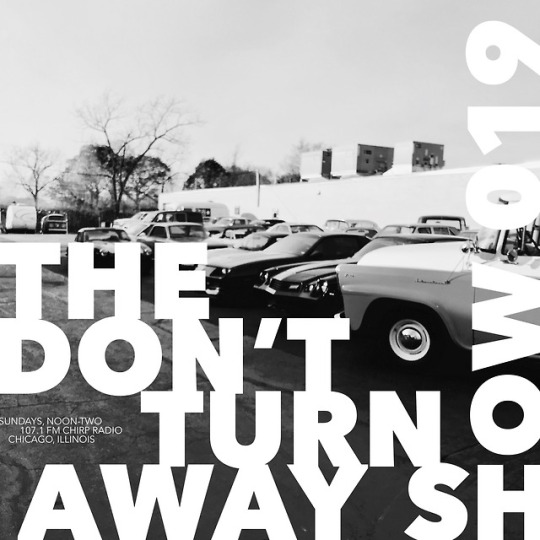
today’s playlist for don’t turn away on 107.1fm chirp radio:
listen on spotify - https://open.spotify.com/user/126045511/playlist/6A41UMMUNpYNt4mBTSbMd7?si=ZXpqyGVvQ8i65Qo3j6S0Jg
01. B.T. Express - “Depend On Yourself” from Energy To Burn (Columbia) 02. Hailu Mergia - “Yegle Nesh” from Yegle Nesha / Hailu (Philophon) 03. Esramo Carlos - “Vita Antiga” from Cachaça Mecânica (Polydor) 04. Serengeti - “kent11″ from To The Max (self-released) 05. Christian Scott The Emancipation Procrastination from The Emancipation Procrastination (Ropeadope) 05. Everything Is Recorded - “Cane” from Everything Is Recorded by Richard Russell (XL) 06. Adrian Daniel - “This City” from Flawd (1990) 07. Khruangbin - “Lady and Man” from Con Todo El Mundo (Dead Oceans) 08. Marcus Marr - “High Times” from Familiar Five EP (DFA) 09. ADT - “New Body” from Insecurities (Hausu Mountain) 10. Robert Moore Can't Help Myself from Everything's Gonna' Be All Right / Can't Help Myself(Saadia) 11. Claudia Lennear It Ain't Easyfrom Phew (Warner Bros.) 12. Buddy Miles - “Them Changes” from Them Changes (Mercury) 13. Joyce Wrice - “Rocket Science” from Rocket Science (Akashik) 14. Positive Force - “We Got The Funk (U.S. Re-edit)” from We Got The Funk (Sugar Hill) 15. Black Milk - “DiVe” from FEVER (Mass Appeal) 16. Femi Kuti - “One People One World” from One People One World (Knitting Factory) 17. Domenico - “Peleleco Zum” from Cine Prive (Plug Research) 18. Fraction and Finsta - “Working On It” from Thoughtwork (self-released) 19. Charlotte Day Wilson - “Nothing New” from Stone Woman (self-released) 20. Phoelix - “Wrong” from (Rooted Classicks) 21. Zacari - “Redemption” (feat. Babes Wodumo) from Black Panther: The Album (Interscope) 22. Donny McCaslin - “Shake Loose” from Beyond Now (Motema Music) 23. Chicago Gangsters - “Gangster Boogie” from I Choose You (Amherst)
#chirp#chirpradio#local radio#radio#chicago#chicago radio#chicago music#music#djs#dj#playlist#vinyl#chicagodj#chicagodjs#tumblrdj#local music#local chicago music#chicago independent radio project#soul#funk#jazz#hiphop#rap#electronic#dance
1 note
·
View note
Text
Steph’s Dumbass OCs Who Run A Train
It’s been nearly a year since these little nerds first popped up in my imagination, so since I reference them here and there I guess I should introduce them properly.
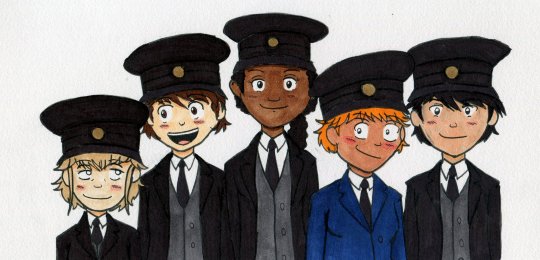
I currently refer to the story under the title of 21st Century Unlimited, named for the famed passenger train 20th Century Limited, which ran from NYC to Chicago for many years and is one of the most famous named trains of all time in the United States.
Synopsis: an independent company has decided to recreate a luxury steam service between the NYC area and Pittsburgh, PA. During testing of their new locomotive, one of the mechanical engineers on the project turned out to have heritage railway experience and did the test driving, and she took so well to the locomotive she helped design that she was offered the driving gig full-time, a chance she jumped at. The planned comic is mostly just the crew of the named passenger train Allegheny Streak being stupid together, with a side of “the engineer and head conductor fall in love and are idiots about it.”
Characters are under the cut!
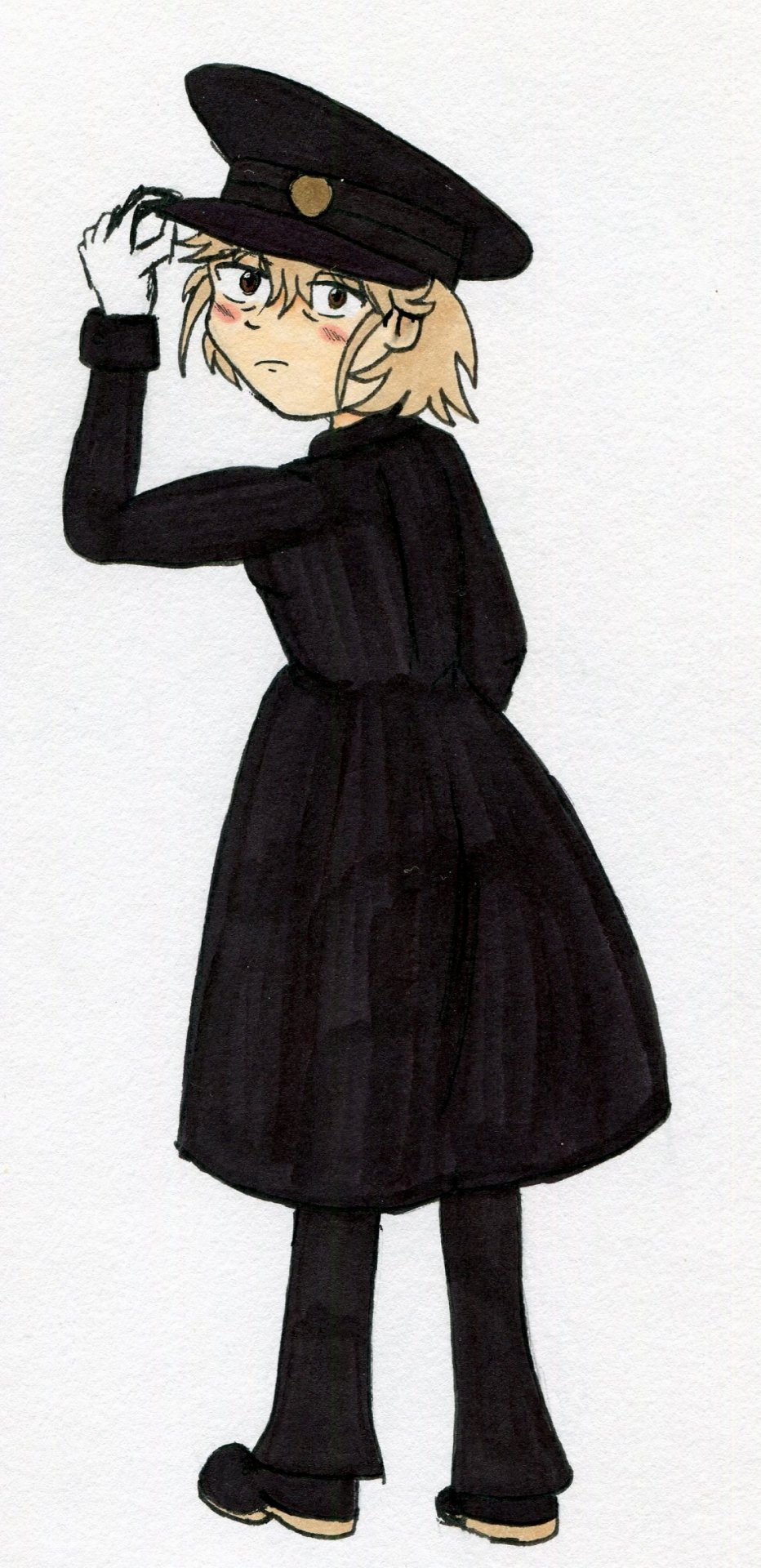
Engineer is more or less the viewpoint character, although things tend to bop around between the members of the crew. Perpetually tired-looking because of an autoimmune thyroid disorder, she was on the design team for the locomotive because her background is actually in mechanical engineering. Her hobby of volunteering at heritage railways throughout her late teens and 20s got her into the cab and driving steam locomotives in her spare time, which led to her driving the locomotive she helped design during testing and winning the driving gig by being a natural with it, essentially making her an engineer x 2. Normally an unassuming, tiny nerd, when she’s on the footplate her confidence soars, and she displays a unique ability to make up lost time that’s unparalleled by the rest of the company’s driving crews. Her childhood hero is Joe Duddington, the engineer who drove Mallard during the record-setting run of July 3rd, 1938, and she does not take slights to Mallard lightly:
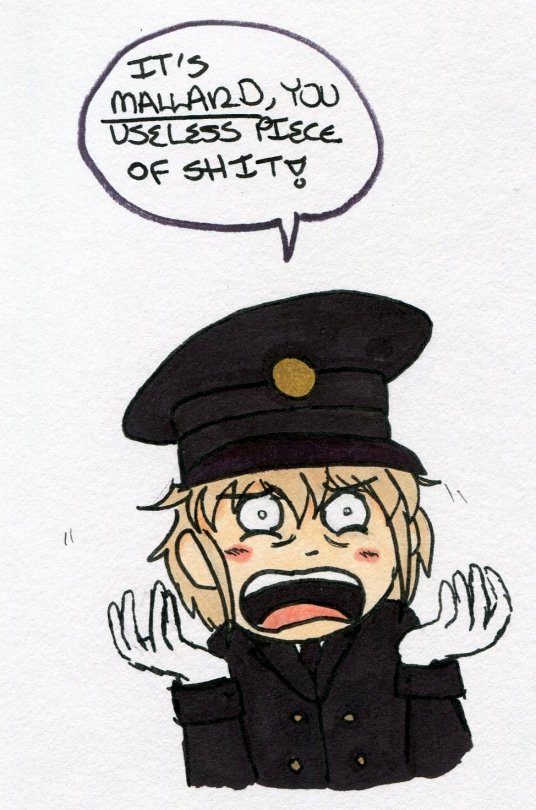
Aside from her fixation on anything Sir Nigel Gresley designed, she lives for playing Splatoon and has a replica Splatling of her own construction in her home. She got to name her locomotive due to being both on the design team and being the driver, so she picked Nasty Majesty, her favorite Splatoon song. Her thyroid disorder has deposited weight on her weirdly and only in the front, which she’s self-conscious about, so she keeps the winter coat from her “dress” uniform on nearly year-round, only taking it off when it’s too warm. Her love of Splatoon led to her bonding instantly with the train’s head conductor, and they’re the best of friends (and Splatoon teammates). She has a crush on him that’s very obvious to her crewmates and frequently blushes up to her ears if things hit her right.
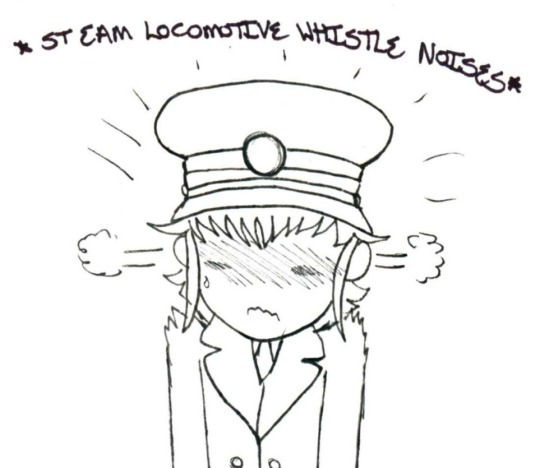
Engineer actually came into being because I wanted to write a character with the same autoimmune thyroid disorder I have, but she also became a way for me to grapple with a lot of my other issues, so there’s a lot of me in her, which makes her really easy for me to write for.

Conductor is responsible for everything on the train that isn’t the locomotive (that’s Engineer’s job). As head conductor, he handles everything from fares to keeping passengers in line, as well as telling Engineer when to get moving. Although they both have radios, he enjoys using hand signals because he knows Engineer is a big enough nerd to know them all. He loves his job and has a timetable collection at his fastidiously organized home, and he also enjoys cooking because he grew up helping his parents at their restaurant when he was younger. A lot of people think because he’s impeccably organized and never has a thread loose with his clothes that he’s very straight-laced, but the truth is that he actually has a massive mischievous streak and won’t hesitate to pull some harmless fun if he can, like activating Alexa units he sees in people’s houses or making singing toys play a round at a department store. (You’ll always know it was him - he gives himself away by laughing.)
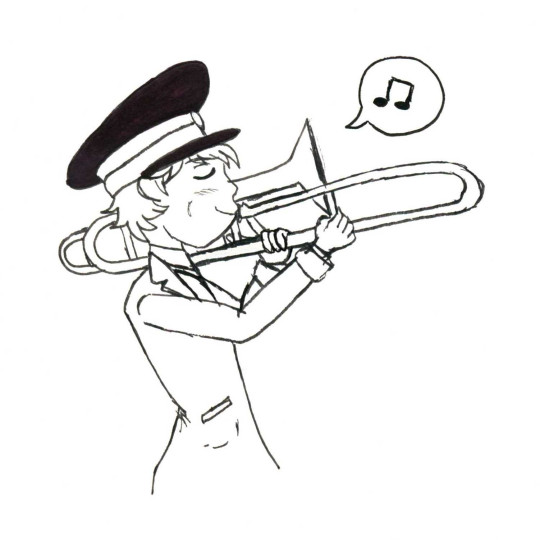
He plays trombone, which he played in both his high school marching band and jazz ensemble, and he enjoys trolling people by Sad Tromboning them with his actual instrument, which he often keeps in the staff car he works out of right behind the locomotive. Also an avid Splatoon player (shooter main, usually the Jet Squelcher), he and Engineer are a fantastic team in the cephalopod paintball game, and he often sends her off to drive with a “Take care out there,” quoting fellow conductor C.Q. Cumber. He has a large amount of interaction with the passengers and sees a bunch of weird ones, but he can never tell the rest of the crew any weird passenger stories without making himself laugh, something the other crew members rag on him affectionately for. He fell in love with Engineer when she displayed her uncanny ability to get to stations exactly on the time listed on the schedule, but he’s a lot better at hiding this from the others. They figure it out anyway.
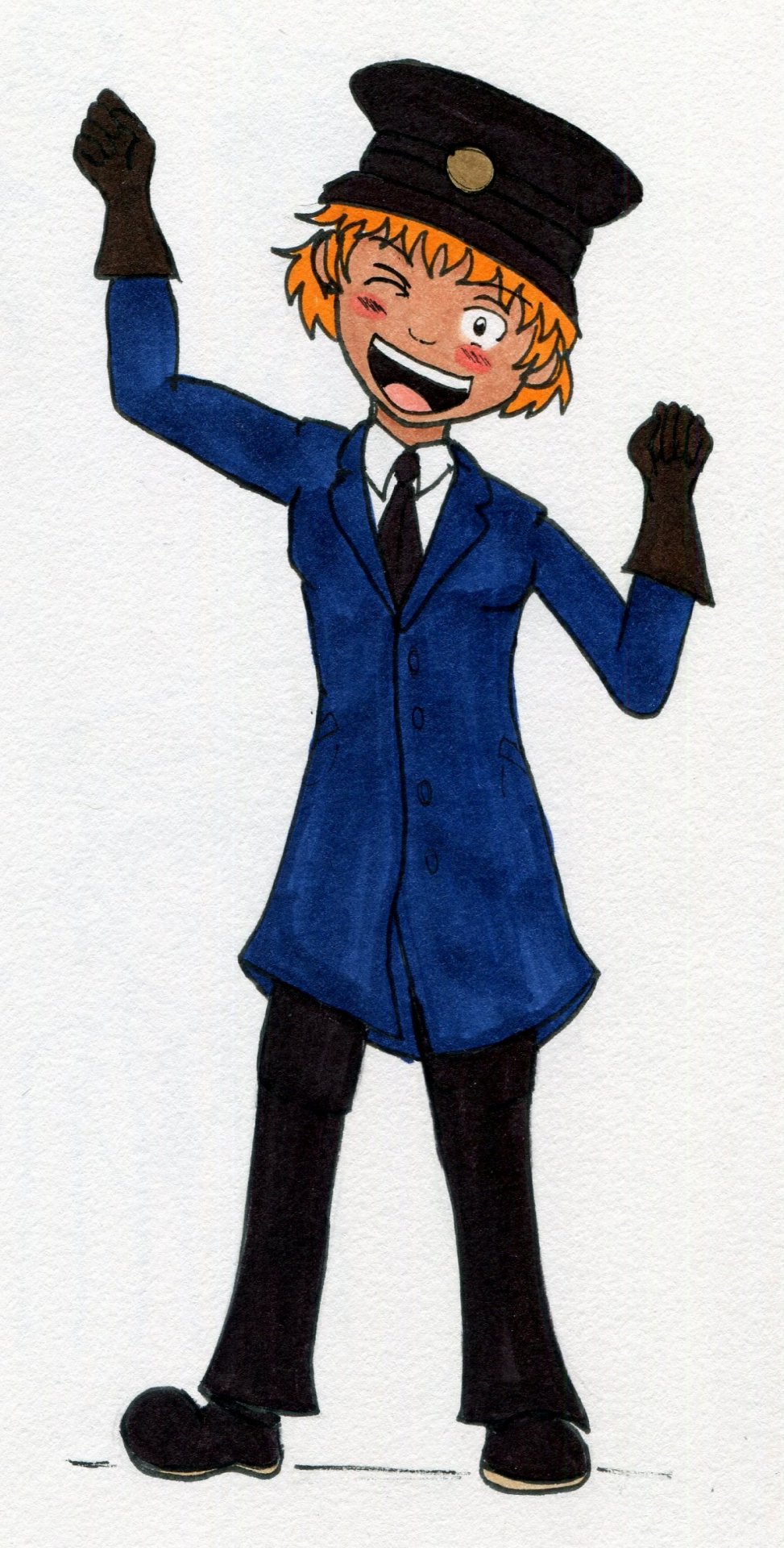
Fireman is in the locomotive with Engineer, shoveling coal and monitoring the boiler. Engineer requested that the company find her a female or non-binary fireman to make a point, and they stumbled upon a strange woman who turned out to be a walking YTP encyclopedia, quotes memes that were popular over fifteen years ago, threatens to fart in the firebox, and playfully antagonizes Engineer over her crush on Conductor like they’re in sixth grade. None of that truly matters, though, because Fireman can shovel like a champ, and although her duster often hides it she has utterly massive arms. Although she was born in America, her father is Scottish and her mother is Bengali, and she got tired of trying to convince people of the Scottish part so she started dyeing her hair orange so they’d believe her. The crew enjoys describing her as “feral,” but she makes sure her antics would never put anyone in danger. You don’t fuck around with trains, after all. She’s an excellent billiards player and she often hustles people in hotels when the crew is in Pittsburgh overnight, using the money to buy them all dinner at Primanti Bros.
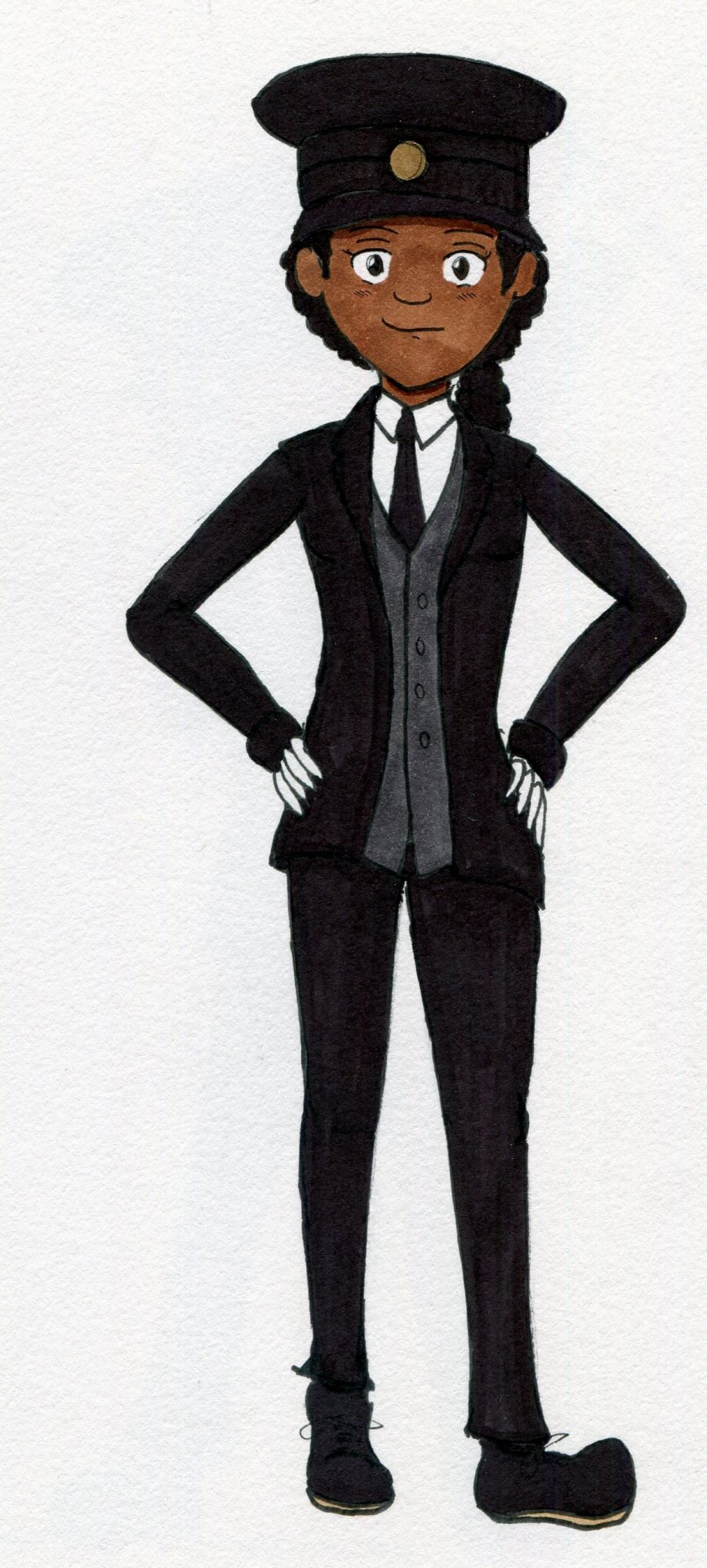
Assistant Conductor is the most “normal” crew member on the surface, but she’s actually a giant weeb and likes making aesthetic Pokemon teams in her spare time. Normally the best at solving social issues with passengers, she often runs into stereotyping due to her height (she’s the tallest crew member and is really tired of being asked if she models or plays basketball or volleyball). Her love of gaming has led her to join Engineer and Conductor’s Splatoon team, where she mains Brellas and Rollers, but she prefers Pokemon above all else and is very good at designing cute teams for people. (She knew exactly what video game Engineer learned that Japanese railway employees salute from and called her out on it.) Her girlfriend, who lives with her, works at the home terminal in the stationmaster’s office.
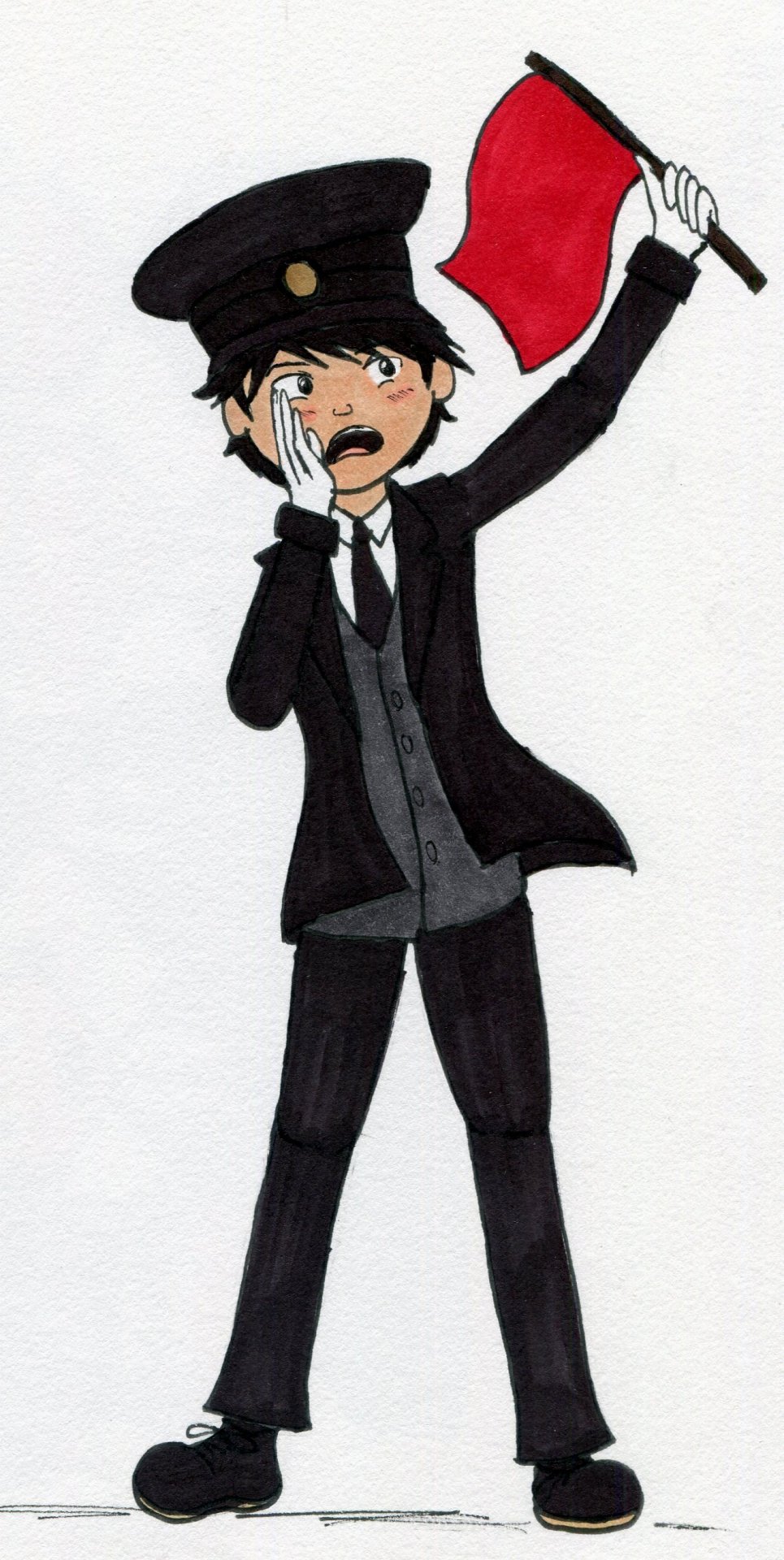
Brakeman is a bit younger than the other four, and he joined the crew for a sense of adventure - he wanted to travel. He longs to have a fight on top of the train like the brakemen in the movies do, but it’s just never going to happen. Because of his love of action, he’s the most front-line player on the crew’s Splatoon team (and a Dualies main), but he doesn’t actually get the sort of real-life action he craves and more often ends up joining in on Fireman’s weird shenanigans instead. He’s young enough to be great at using TikTok, but the other four crew members miss Vine and will not hesitate to tell him this on a regular basis whenever they get the chance. His other hobbies include playing Among Us and screwing over annoying children to help the non-annoying children win, and he’s actually really good at finding and exposing creeps in gaming spaces because of this.
11 notes
·
View notes
Photo
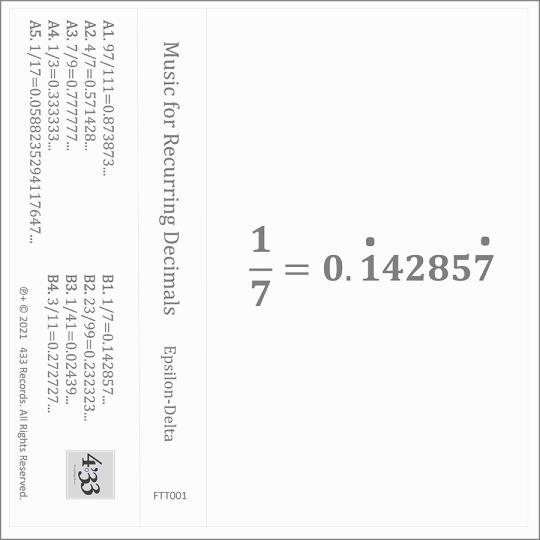

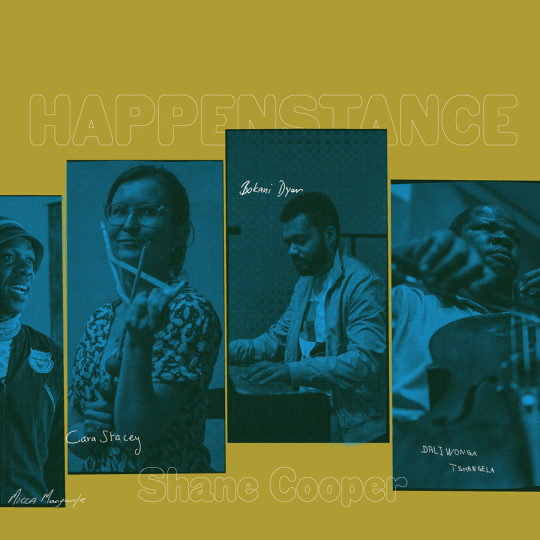


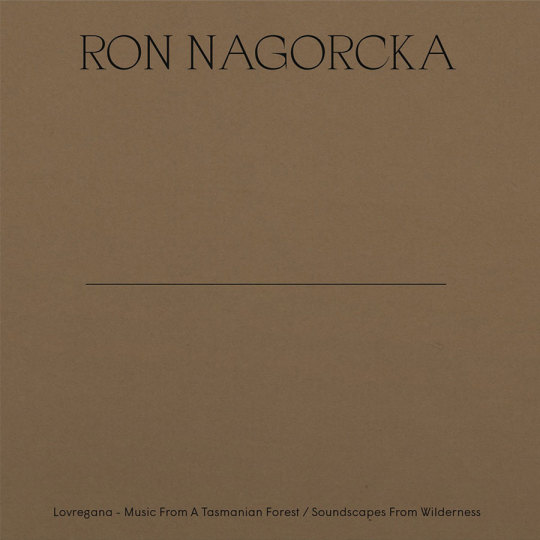
Music reviews by Laurent Fairon, July 2021 Epsilon-Delta – Music for Recurring Decimals (March 2021) Dino Felipe – The Gardeners (June 2021) Shane Cooper – Happenstance (June 2021) RhaD – Metamusic (June 2021) Angel Bat Dawid – Hush Harbor Mixtape Vol. 1 Doxology (June 2021) Ron Nagorcka – Lovregana - Music From A Tasmanian Forest (July 2021)
Epsilon-Delta – Music for Recurring Decimals (433 Records) https://433records.bandcamp.com/album/music-for-recurring-decimals Lovely collection of short, poetic synth sequences build on simple mathematical algorithms by Hong Kong mathematician Addy Choi working under the Epsilon-Delta alias. Algorithms are based on decimal fractions like 4/7, 7/9 or 3/11, using the resulting digits as the basis for the sequence. Far from being arid or too cerebral, the tracks are poetic and varied thanks to the beautiful MIDI synth sounds chosen by the programmer, who is also a clever musician apparently. Tracks may be repetitive but the album isn't. This is textbook Systems Music as practiced in the U.K. during the 1980s by the likes of The Dead Goldfish Ensemble or The Lost Jockey. Exquisite album.
Dino Felipe – The Gardeners (self release) https://dino-felipe.bandcamp.com/album/the-gardeners Mini-LP of 16 very short tracks by Miami-based electronic musician with previous full length releases on ¡Mayday! and Schematic. The music on The Gardeners is based on samples, sound collages, occasional beats and various sound treatments like speed modification, sound stretching, accumulation, heavy reverb, or else. Felipe thus creates colorful and humorous vignettes based on ethnic music snippets, found vocals, musique concrète or cheap electronic sounds. Glitch-y textures abound, as well as grotesque sounds and weird juxtapositions, the music being deliciously direction-less and erratic.
Shane Cooper – Happenstance (Kit Records) https://kitrecs.bandcamp.com/album/happenstance Gorgeous ambient, ethnic and experimental jazz music by South African double bass player and multi-instrumentalist Shane Cooper. The album is actually constructed as a collage of short excerpts from sessions recorded with Johannesburg guest musicians in 2020. The whole project was commissioned by contemporary artist William Kentridge's The Centre for the Less Good Idea, an artist run facility he founded in Johannesburg to promote local independent art projects. Cooper obviously selected the interesting and relevant parts from two days' worth of collective improvisations and the 2 side-long tracks of Happenstance are bursting with ideas and surprises. The 1st side is rather varied in instrumentation, including superb piano and cello parts, lush Rhodes electric keyboard notes and incredible South African traditional instruments played by Cara Stacey. The music is moody and adventurous, jumping gracefully all over the place. The flip side is more about exploring rhythm textures and deep bass sounds and features Shane Cooper on double bass along 3 percussionists. The collage technique is applied here as well, producing pleasant mood changes and exciting U-turns. Cooper delivers a variety of sounds on his instrument, from walking bass lines to long-held notes played with arco (briefly played backward at some point), and also performs beautiful electric bass guitar parts with reverb. The non-linearity and unpredictability of the collage strategy used in Happenstance ensures the music is keeping away from jazz music's clichés and each new listen is surprising and interesting. Two more episodes were recorded during these sessions and are available on YouTube and other platforms, like the vocal only piece called 'Tongues'.
RhaD – Metamusic (Unexplained Sounds Group) https://unexplainedsoundsgroup.bandcamp.com/album/metamusic Standing for Research for Historical Audio Documents, RhaD is a musical project by Italian music activist Raffaele Pezzella, also known as electronic music producer Sonologyst, as well as Unexplained Sounds Group label director and publisher, not to mention radio host and sound researcher, among others. Metamusic is a 40mn sound collage of mysterious radio transmissions, found vocals, spoken words, vintage electronic sounds and a number of guest stars on classical music instruments like organ, guitar, bass or piano – respectively Michael Bonaventure, Stefan Schmidt, Daniel Barbiero, Francesco Arrighi and Mara Lepore. Adroitly avoiding any ca 2021 digital artifact along the way, Metamusic's sound design is bringing the listener back to the glorious 1960s and '70s, yet the music sounds rather timeless to these ears. Metamusic recreates the sound of early European avantgarde with plenty of tape manipulations, sound collages, buzzing sounds, French spoken word and contemporary classical music instruments. The sound crafting is superb, the collage technique creating an ever-changing musical soundscape full of weird sounds, grotesque sound manipulations and Surrealist juxtapositions. What's not to love?
Angel Bat Dawid – Hush Harbor Mixtape Vol. 1 Doxology (International Anthem) https://intlanthem.bandcamp.com/album/hush-harbor-mixtape-vol-1-doxology Very personal and original album by Angel Bat Dawid, a US clarinet player, singer, electronic musician and DJ from Chicago. Created with a few sounds and a minimum of means, devoid of spectacular solo outing, these mostly desolate tracks form a meditative musical travelogue through the Black people psyche. Track titles deal with themes of slavery, racism, and Black culture tropes, though neither the occasional lyrics nor the strange music on offer here can pass for angry or vindicatory, the music being far too personal for that. The clarinet confers a neo-classical atmosphere to some of the tracks, sometimes interestingly contrasted with synthesizer sounds or electronic beats. Harmonica and vocals on Autotune also contribute to the unique sound signature of this album, with occasional hints at gospel and rural blues. Playing in continuous mode in a kind of stream-of-consciousness style, the music would work just fine as a soundtrack to a Kara Walker exhibition—Bat Dawid actually composed the soundtrack to a Yoko Ono outdoor installation in 2020. On a side note, she also released the Harkening Etudes mini album on Longform Editions earlier in April 2021, where her classically-trained clarinet playing is contrasted with sampled piano accompaniment and electronically processed vocals in a series of short, bizarre classical music études, also worth checking out.
Ron Nagorcka – Lovregana - Music From A Tasmanian Forest (Invisibilia) https://invisibilia.bandcamp.com/album/lovregana-music-from-a-tasmanian-forest-1990-soundscapes-from-wilderness-1988 This CD reissue combines 2 cassette tapes of manipulated field recordings by Australian composer Ron Nagorcka, born 1948, namely 'Lovregana - Music from a Tasmanian Forest', 1990, and 'Soundscapes from Wilderness', from 1988. Both are based on bird recordings from northern Tasmania island, where Nagorcka relocated in 1988, building himself a house and makeshift, solar-powered recording studio deep in the primeval forest. On Lovregana, short samples of bird songs are run through a sampler and harmonized in just intonation, producing eerie soundscapes of disembodied and supernatural bird singing. The music is reconstructing a fictional and artificial forest populated by dozens of birds, some far in the distance, some near ; some slowly developing a song, others performing in sudden bursts, with a variety and unpredictability akin to actual birds in nature. To this, Nagorcka adds minimal electronic loops in the background, dreamy synthesizer notes in strange tunings and discreet didgeridoo playing, all very well integrated to the sampled bird songs. These tracks are thus poetical evocations of a primeval forest via electronic sounds. While Lovregana's tracks more or less focused on one specific bird song at a time, the two tracks of 'Soundscapes from Wilderness' take a more holistic approach to nature recordings. The 1st track, 'Black Forest, Victoria', is a reconstruction of the deep forest sounds via the accumulation of various field recordings, creating a particularly dense soundscape through layers and layers of nature recordings. Here again, the natural-vs-artificial dichotomy is what interests the composer, and arguably this forest never existed, it was rather reconstructed in the studio. The 2nd track, 'Rainforest in Northern Tasmania', uses forest sounds as the basis for slow, mysterious didgeridoo improvisations, perhaps examining how the musician can dialog with the environment, being a part of it, being one with it. The superb didjeridoo playing is what fascinates most here. . . .
11 notes
·
View notes
Text
Dust Volume 6, Number 8

Angel Olsen
Now half a year in the pandemic, we’re starting to see the emergence of quarantine records, whether in the trove of reissues hastily assembled to stand in for new product or home recorded projects made with extremely close friends and family or albums that are conceived and written around the concept of isolation. Music isn’t real life, exactly, but it lives nearby. And in any case, it’s still music and can be good or bad whether it’s been unearthed from a forgotten box of tapes, recorded at home without collaboration or side people or technologically gerry-rigged so that distanced partners can work together. So, as long as you all are making music, we will continue to listen and find records that move us, as the world burns all around. This edition’s contributors included Patrick Masterson, Andrew Forell, Tim Clarke, Jennifer Kelly, Bill Meyer, Jonathan Shaw, Justin Cober-Lake and Ray Garraty. Enjoy.
+ — #playboy (Deluxe Edition) (self-released)
#playboy (deluxe edition) by +
One of the most genuinely confounding records I’ve heard this year comes courtesy SEO-unfriendly artist + aka Plus Sign fka Emanuel James Vinson, a Chicago rapper, city planner and all-around community activist who spends his time helping with the city’s Let’s Build Garden City initiative when he’s not making music (which is frequent, by the way — take a look at the breadth of that Bandcamp discography). The concept with #playboy, originally released in April but deluxed in late May, is simple: Two kids find a music machine called #playboy in their basement and start tinkering with it. Its childlike whimsy is conveyed in the song titles (“Getting the Hang of It,” “Wake Up Jam (Waking Up)”) every bit as much as it is in the music, with occasionally grating indulgences, the odd earworm and a brief appearance by borderless internet hip-hop hero Lil B that makes perfect sense in context; the kindred spirit of that community-building cult auteur is strong here. You may wind up loving this record or you may wind up hating it, but I can promise you this: You’ll be thinking about it and the artist behind it long after it’s over.
Patrick Masterson
Actress — Mad Voyage Mixtape (self-released)

I once suggested Darren Cunningham mucks about with his music because he can’t help himself. That was about six years ago on the occasion of his purported “final” album Untitled; with the benefit of hindsight, we can see he was (like so many others, to greater or lesser consequence) just pulling our leg with that PR. Hell, he’s released two albums worth of music in July alone: The first was the mid-month surprise LP 88, which follows in the vein of his acclaimed high period as an often brilliant, occasionally frustrating patchwork of submersible beats best played at high volume with a low end. The second came at the end of the month in an m4a file shared the old fashioned way on a forum via Mediafire link, nearly an hour and a half long, and per the man himself, “All SP-303, sketchbook beats, recorded this past week [the first week of July] straight to recorder or cassette.” It feels very much like a homespun Actress mixtape and is probably best thought of as livelier accompaniment to 88 but, even still, there’s no noticeable drop in quality — once Actress, always Actress. If headier lo-fi beat tapes are your beat, this will slot comfortably in line.
Patrick Masterson
bdrmm - Bedroom (Sonic Cathedral)
youtube
Hull five-piece bdrmm play a satisfyingly crepuscular version of shoegaze on their debut album Bedroom. Ryan Smith, his brother Jordan on bass, guitarist Joe Vickers, Danny Hull on synths and drummer Luke Irvin combine the widescreen sound of Ride with a cloak of gothic post-punk. Like the late, lamented Girls Names, bdrmm find a sweet spot where atmosphere and dynamics either build to euphoric crescendos or bask in bleak funereal splendor. Bedroom seems deliberately sequenced from celebration to lament. “A Reason To Celebrate” evokes Ride at their most anthemic, the tripping staccato driven “Happy” summons the spirit of The Cure of Seventeen Seconds before the pace drops for the second half, the songs become quieter and darker as the band finds a more personal voice. “(The Silence)” is an ambient whispered wraith of a thing, “Forget The Credits” impressively mopey slowcore. bdrmm don’t always transcend their influences, but this debut is an atmospheric treat if your taste runs to the darker end of the musical buffet.
Andrew Forell
Circulatory System — Circulatory System (Elephant 6 Recording Co.)
Circulatory System by Circulatory System
Nearly 20 years after its initial release, the excellent eponymous debut album by Will Cullen Hart’s psychedelic chamber-pop band Circulatory System gets a long overdue vinyl reissue. While his previous project, the undeniably great Olivia Tremor Control, tended to lean more towards classic psych-pop’s traditional tropes — hard-panned drums, loads of disorientating tape effects, wonky harmonized vocals — Circulatory System taps into something utterly uncanny. Both Signal Morning (2009) and Mosaics Within Mosaics (2014) have their moments, but this is front-to-back brilliant, conjuring a sublime atmosphere of reflective estrangement. The music is a thick, grainy soup of shimmering instrumentation, from the eerie (“Joy,” “Now,” “Should a Cloud Replace a Compass?”) to the joyful (“Yesterday’s World,” “The Lovely Universe,” “Waves of Bark and Light”), but part of the album’s magic is the way everything flows into a seamless whole. As is vinyl’s tendency, the rhythm section really comes alive here, the fuzz bass and tom-heavy drum parts booming out, with plenty of vivid details in the mix swimming into view. A worthy reissue of an essential album.
Tim Clarke
Cloud Factory — #1 (Howlin’ Banana)
Cloud Factory #1 by Cloud Factory
Cloud Factory, from Toulouse, France, overlays the serrated edges of garage pop with a serene dream-pop drift. It’s an appealing mix of hard and soft, like being pummeled to death by pillows or threatened gunpoint by a teddy bear. “Amnesia,” for instance, erupts in a vicious, sawed off, trouble-making bass line, then soars from there in untroubled female vocals. Later, “No Data,” punches hard with raw percussion, then lays on a liquid, lucid guitar line that encourages middle-distance staring. None of these songs really up the ante with memorable melodies, sharp words or that intangible R’NR energy that distinguishes great punk rock from the so so. Not loud, not soft, not great, not bad. Cloud Factory resides in the indeterminant middle.
Jennifer Kelly
Entry — Detriment (Southern Lord)
Detriment by Entry
Nuthin fancy here, folks. Just eight songs — plus a flexing, fuzzing intro — of American hardcore punk. Entry has been grinding away for a few years now, and Detriment doesn’t advance much past the musical terrain the band marked off on the No Relief 7-inch (2016). That’s OK. The essential formula is time tested: d-beat rhythms, overdriven amps and Sara G.’s ferocious vocals delivering the necessary affect. That would be: pissed off, just this side of hopeless. Detriment sounds like what might happen if Poison Idea (c. 1988) stumbled into a seminar on Riot Grrrl; after everyone got tired of beating the living shit out of one another, they’d make some songs. “Selective Empathy” is pretty representative. Big riffs, a breakdown, and more than enough throaty yelling to let you know that you’re in some trouble. You might recognize the sound of Clayton Stevens’ guitar from his work with Touché Amoré — but maybe it’s better if you don’t. This isn’t music for mopery. Watch out for the spit, snot and blood, and flip the record.
Jonathan Shaw
Equiknoxx — VF Live: Equiknoxx (The Vinyl Factory)
youtube
There’s nothing like a little roots music to get you through the sweltering summer heat, and this early July mix by Gavin “Gavsborg” Blair (half of forward-thinking Kingston dancehall unit Equiknoxx) was a personal favorite of the past month for hitting that spot. The group tends to throw curveballs at the genres it tinkers with, and Blair’s mix highlights why they’re so good at it: The crates run deep. Spanning everything from legendary producer and DJ Prince Jazzbo to in-house music fresh out the box (e.g., “Did Not Make This For Jah_9” was released in late May), Blair sets the mood and educates you along the way. Like everything else these cats do (and that includes the NTS show — support your independent radio station!), it’s hard not to give the highest recommendation.
Patrick Masterson
Ezra Feinberg — Recumbent Speech (Related States)
Recumbent Speech by Ezra Feinberg
Knowing that Ezra Feinberg is a practicing psychoanalyst, it’s tempting to read meaning into the name of his second solo album. But be careful to think twice about the meaning you perceive and ask yourself, is it the product of Feinberg on the couch or your own projection? His choice to name one of the record’s six instrumentals (there are voices, but no words) “Letter To My Mind” certainly suggests that there’s an internal dialogue at work, but the music feels most like a layered deployment of good ideas than an exchange of intrapsychic forces. The synthesizers shimmer and cycle like something from a mid-1970s Cluster record, resting upon a pillow of vibraphone and electric piano tones, which in turn billow under the influence of undulating layers of drums. Feinberg’s guitar leads are bright and pithy, like something Pat Metheny might come up with if he knew he was going to have to pay a steep price for every note he played. Ah, but there I go, projecting an implication of adversary process where there may be none. Might it be that Feinberg, having spent a full work week immersed in the psychic conflicts of others, wants to lay back on the couch and exhale? If so, this album is an apt companion.
Bill Meyer
Honey Radar — Sing the Snow Away: The Chunklet Years (Chunklet)
Sing the Snow Away: The Chunklet Years by Honey Radar
Jason Henn of Honey Radar has a solid claim at being his generation’s Bob Pollard, a prolific, absurdist songwriter, who tosses off hooky melodies as if channeling them from the spirit world. His least polished material glints with melody hidden beneath banks of fuzz, whispery and fragile on records, but surprisingly muscular in his rocking live shows. This 28-song compilation assembles the singles, splits, EPs and bonus tracks Henn recorded for Chunklet between 2015 and the present; it would be a daunting amount of material except that it goes down like cotton candy, sweet, airy, colorful and gone before you know it. Like the Kinks, Henn has a way of making strident rock and roll hooks sound wistful and dreamy. In “Lilac Pharmacy,” guitar lines rip and buck and roar, but from a distance, hardly disrupting Henn’s placid murmur. “Medium Mary Todd” ratchets up the tension a bit, with a tangled snarl of lick and swagger, but the vocals edge towards quiet whimsy a la Sic Alps; a second version runs a bit hotter, rougher and more electric, while a third, recorded at WFMU, gives an inkling of the Honey Radar concert experience. A couple of fine covers — of the Fall’s early rant “Middle Class Revolt” and of the Monkees rarity “Wind-Up Man”— suggest the fine, loamy soil that Henn’s art grows out of, while alternate versions of half a dozen tracks hint at the various forms his ideas can take. It’s a wonderful overview of Honey Radar so far, though let’s hope it’s not a career retrospective. Henn has a bunch of records left to make yet if he wants to edge out Pollard.
Jennifer Kelly
Iron Wigs — Your Birthday’s Cancelled (Mello Music Group)
Your Birthday's Cancelled by IRON WIGS
As an adjective, “goofy” had gotten a bad rep in hip hop. Anything that is unusual, inventive and not in line with “keeping it real” is immediately stigmatized as goofy, weird, nerdy and bad. Iron Wigs is goofy but hold the pejorative connotations. Chicago representatives Vic Spencer and Verbal Kent team up here with Sonnyjim from the UK to do some wild rhyming. They collaborated before, but Your Birthday’s Cancelled is a complete, fully fleshed project, masterfully executed from start to finish. Instead of the usual gun busting you get a fist in the ribs. Instead of drug slinging, a blunt to activate your rhymes. Each member of the group has a distinctive delivery which makes you to listen carefully for every verse, no skipping. It’s a relief to listen to rap artists who don’t pretend they’re out in the streets while they’re at home enjoying a favorite TV series. The standout track here is “Bally Animals & Rugbys” with Roc Marciano dropping by for a verse.
Ray Garraty
Levinson / Mahlmeister — Shores (Trouble In Mind)
Shores by levinson / mahlmeister
Jamie Levinson and Donny Mahlmeister’s Bandcamp page indicates that they’re based in Oak Park, a suburb of Chicago. This goes further towards explaining their association with Trouble in Mind Records, which is located in the same county, than their music, which brings to mind something much further north. The duo’s music is mostly electronic, with modular synthesizers setting the pulse and sweeping the pitch spectrum while lap steel guitar adds flourishes and a shruti box thickens the textures. The album is split into two, with each track — one is named “Ascend,” the other “Release” — taking up one side of a 50-minute cassette. The first side trundles steadily onwards, and the second seems to bask in a glow to that never totally fades. Since there’s no “Descend,” it’s easy to imagine this music sound tracking a drive into the Canadian north, the journey unspooling under a sky that never darkens, its progress towards Hudson Bay unhindered by other traffic or turns in the road. Perhaps that’s just one listener’s fantasy of easy social distancing and escape from the present’s grim digital glare into a retro-futurist, analog dream. But in dreams we’re free to fly without being seated next to some knucklehead with his mask over his eyes instead of his mouth, so dream on, dreamers. This tape is volume one of the Explorers Series, Trouble in Mind’s projected program of limited edition cassette releases.
Bill Meyer
Klara Lewis — Ingrid (Editions Mego)

Klara Lewis’s latest recording shows a narrowing of focus. Previously she seemed to be trying ideas and methods on for size, investigating ambient electronics or hinting at pop melody without completely committing. Given the approach to music modeled by her father, Graham Lewis of Wire and Dome, she probably does not feel the need to do just one thing, and that’s a healthy angle if one wants to stay interested and flexible. But there’s also something to be said for really digging into an idea, and that’s what she has done here. Ingrid is a one-track, one-sided 12.” Burrowing further into one-ness, it is made from one looped cello phrase, which gets filtered and distorted on each pass. The effect suggests decay, but not so much the gradual transformation of a William Basinski piece as the pitiless abrasion of a woodworker going over a plank with sander. The combination of repetition and coarsening hits a spot closer to one that Tony Conrad might reach, and that’s an itch worth scratching.
Bill Meyer
Luis Lopes Humanization 4tet — Believe, Believe (Clean Feed)
youtube
The cruel economics of contemporary creative music-making favor an ensemble like Humanization 4tet. At a minimum, the filial Texan rhythm section of Stefan and Aaron Gonzalez (drums and bass respectively) and Lisbon-based duo of Rodrigo Amado (tenor saxophone) and Luís Lopes can each count on having the other half of a band on the other side of the Atlantic. But any project that’s on its fourth record in a dozen years has more going for it than the chance to save on plane tickets. For the Portuguese musicians, it’s an opportunity to feel an unabashedly high-energy force at their backs, as well as a chance to drink from a deep well of harmolodic blues. And for the Gonzalez brothers, it’s the reward of being the absolute right guys for the job; it has to be a gas to know that the heft they put into their swing is so deeply appreciated. While Lopes’ name remains up front, everyone contributes compositions, and everyone gives their all on every tune.
Bill Meyer
Joanna Mattrey — Veiled (Relative Pitch)
Veiled by Joanna Mattrey
This solo CD, which closely follows a collaborative cassette on Astral Spirits, is only the second recording with Joanna Mattrey’s name on the spine. But Mattrey is no newcomer. The New England Conservatory-trained violist has been playing straight and pop gigs for a while. If you caught Chance the Rapper on Saturday Night Live, Cuddle Magic with strings or a host of classical gigs around New York City, you’ve seen her. But if black dress and heels gigs pay her bills, improvised music nourishes her heart. And if sounds raw enough to scrape the roof of the world nourish yours, this album is new food. The premise of Veiled is finding veins of concealed beauty concealed, and that search impels Mattrey to tune her viola to sound like a horse-haired Tuvan fiddle, clamp objects to the strings and blast her signal through some satisfyingly filthy amplification. And whether it’s a slender tune or a complex texture, the reward is always there.
Bill Meyer
Angel Olsen — “Whole New Mess” single (Jagjaguwar)
youtube
Everyone processes a breakup differently (though, to be fair, that’s probably less true now than ever). For Angel Olsen in 2018, it meant retreating to The Unknown, a century-old church in Anacortes, Washington, that Mount Eerie’s Phil Elverum and producer Nicholas Wilbur made into a recording studio. What ultimately came from those sessions was All Mirrors, but Whole New Mess is a chance to revisit that album (fully nine of these 11 songs are ones you’ve heard before; only the title-track and “Waving, Smiling” are new) in a more intimate framework — just Angel, a guitar, a mic and her reverberant heartache. The most cynical view to be taken here is that it’s a stopgap capitalizing on people’s vulnerability amid a pandemic quarantine, but it could also be a corrective for the bloat of All Mirrors, a record I listened to once and haven’t thought about since. Late Björkian excess doesn’t suit her nearly as well as the light touch delivered herein, and your interest will similarly hinge on how much Whole New Mess sounds like the old one.
Patrick Masterson
Ono — Red Summer (American Dreams)
Red Summer by ONO
Ono, the long-running noise-punk-poetry-protest project headed by P Michael Grego and travis, tackles the Red Summer of 1919, evoking the brutal race riots that erupted as soldiers returned from World War I. During that summer, conflicts raged from Chicago to the deep south, as white supremacists rioted against newly empowered returning Black veterans and an increased number of Black factory workers employed in America’s northern factories. Ono captures the violence—and its links to contemporary race-based conflicts—in an abstract and visionary style, with travis declaiming against an agitated froth of avant garde sound. “A Dream of Sodomy” lurches and rolls in funk-punk bravado, as travis declaims all the nightmarish scenarios that haunt his nocturnal hours, while “Coon” natters rhythmically across a fever-lit foundation of hand-drums, mosquito buzz and flute. “26 June 1919” wanders through a blasted, rioting landscape, sounds buzzing and pinging and roaring around travis’ fractured poetry. “White men, red men, Manchester town, send ‘em home, Oklahoma, send ‘em home, in a Black man house, send ‘em home, send ‘em home,” he chants, ominously, vertiginously. The center isn’t holding, for sure. The disc closes with the uneasy truce of “Sycamore Trees,” where steam blasts of synthesizer sound rush up and around travis’ vibrating, basso verses about meeting under the sycamore trees, a metaphor like the blues and gospel and nearly all Black music is full of metaphor about reuniting in a better place. Powerful.
Jennifer Kelly
Julian Taylor — The Ridge (Howling Turtle, Inc.)
youtube
Singer-songwriter Julian Taylor does the little things well. That's not to say that he doesn't do the obvious things well, too, on his latest release The Ridge. His easy voice fits his songs, letting autobiography come with comfortable phrasing. As a writer, he tends toward the straightforward, avoiding extended metaphors or oblique references. The title track considers a particular form of life, and Taylor sticks to the tangible, singing about the stable, “Shovel manure, clean their beds, and prepare the feed for the day.” Taylor's songs make sense of the immediate world and relationships around him, but they avoid woolgathering. The album feels a bit removed from the current climate, but that's no complaint when Taylor's developed a welcoming place to visit. It isn't always easy here, but it's always companionable.
But back to those little things. Each song has carefully detailed orchestration and production. The record goes down easy whether tending toward James Taylor, Cat Stevens or something closer to country, and much of that easiness comes from the precise placement of every note. Burke Carroll's pedal steel, for instance, never exists for its own sake, but to serve the lyric that Taylor sings. The album contains enough space to feel like a rural Canadian ridge, with details drawn into to support Taylor's direct stories. The Ridge could easily go unnoticed (unobtrusiveness not being a highly rewarded trait), but its subtlety and care make it worth taking your boots off and sitting down for a minute.
Justin Cober-Lake
Various Artists — For a Better Tomorrow (Garden Portal)
For A Better Tomorrow by Various Artists
Compilation albums loom large in the American Primitive Guitar realm. Takoma, Tompkins Square and Locust all had larger ambitions than merely offering a sampling of wares, and to them, Garden Portal says, “hold my beer. I’ve got some collecting and playing to do.” For A Better Tomorrow started out as a Bernie Sanders fundraising endeavor. But when Bernie bailed and COVID-19 came on the scene, Garden Portal pivoted to support Athens Mutual Aid Network, an umbrella organization that coordinates aid to the underserved in this trying time. But in addition to good works, there’s some good work going on here. Not all of it is guitar-centric, but even the tracks that aren’t are close enough to the strings and heart template of the aforementioned parties to merit consideration under the same rubric. Joseph Allred’s been ultra-productive recently, so it’s actually helpful to be reminded of the spirit that infuses his playing by listening to it one track at a time. Rob Noyes’ “Diminished” takes the listener on a deep dive into the construction of sentiment and sound. And Will Csorba’s Pelt-like blast of fiddle drone, “Requiem for Ociel Guadalupe Martinez,” will put your hair up high enough to make that self-inflicted quarantine do a bit easier to execute.
Bill Meyer
Various Artists — The Storehouse Presents (The Storehouse)
The Storehouse Presents by The Storehouse
The coronavirus pandemic put the brakes on many things. You doubtless have your own list of loss, but for the proprietors of The Storehouse, the catalog of things kissed goodbye directly corresponds to their endeavor’s inventory of reasons to be. Over the past few years, the Storehouse has invited audiences out to a West Michigan farmhouse to enjoy a potluck meal and a concert played by some musicians of note. If there had been no lockdown, listeners could have enjoyed the Sun Ra Arkestra last April. Instead, no one’s playing, and no one’s getting paid, so the Storehouse has compiled this set of live and exclusive studio tracks to sell on Bandcamp in order to benefit the musicians and the Music Maker Relief Foundation. The cause, is good, but so are the tunes. Want to hear Steve Gunn and William Tyler in sympathetic orbit? Or Joan Shelley pledging her love? Or the first hints of Mind Over Mirrors’ new direction? Step right this way, preferably on one of 2020’s first Fridays.
Bill Meyer
Z-Ro — Rohammad Ali (1 Deep Entertainment / Empire)
youtube
On one of his previous tracks, Z-Ro admitted that he’s basically just writing the same song over and over again (that’s how meta he is now, writing songs on writing songs). While he exaggerated a bit, he was not that far from the truth. In the last half dozen years he’s been writing the same three or four songs in various combinations, reconfigurations and forms. Rohammad Ali follows the same template: haters hate him, but he’s OK and is counting his money. Multiply this by 17, and here is the album. Despite this self-cannibalizing (lots of poets did that), Z-Ro with every new album sounds fresh and far from tired. The self-repeats just fuel him. Rohammad Ali has only one rap guest, and it’s Shaquille O’Neal whose rap career didn’t jump off in the 1990s. A lack of guests only proves that Z-Ro can self-sustain without support from the outside. The only thing from the outside he needs is hate.
Ray Garraty
#dusted magazine#dust#+#patrick masterson#actress#bdrmm#andrew forell#circulatory system#tim clarke#cloud factory#jennifer kelly#entry#jonathan shaw#equiknoxx#ezra feinberg#bill meyer#honey radar#iron wigs#jaime levinson#donny mahlmeister#ray garraty#klara lewis#luis lopes humanization 4tet#joanna mattrey#angel olsen#ono#julian taylor#justin cober-lake#garden portal#the storehouse
3 notes
·
View notes
Text
M. C. Hammer

Stanley Kirk Burrell (born March 30, 1962), better known by his stage name MC Hammer (or simply Hammer), is an American rapper, dancer, record producer and entrepreneur. He had his greatest commercial success and popularity from the late 1980s until the early 1990s. Remembered for his rapid rise to fame, Hammer is known for hit records (such as "U Can't Touch This" and "2 Legit 2 Quit"), flashy dance movements, choreography and eponymous Hammer pants.
A multi-award winner, M.C. Hammer is considered a "forefather/pioneer" and innovator of pop-rap (incorporating elements of freestyle music), and is the first hip hop artist to achieve diamond status for an album. BET ranked Hammer as the No. 7 "Best Dancer Of All Time". Vibe's "The Best Rapper Ever Tournament" declared him the 17th favorite of all-time during the first round.
Burrell became a preacher during the late 1990s with a Christian ministry program on TBN called M.C. Hammer and Friends. Additionally, he starred in a Saturday-morning cartoon called Hammerman in 1991, and was executive producer of his own reality show called Hammertime, which aired on the A&E Network during the summer of 2009. Hammer was also a television show host and dance judge on Dance Fever in 2003, was co-creator of a dance website called DanceJam.com, and is a record label CEO while still performing concerts at music venues and assisting with other social media, ministry and outreach functions. Prior to becoming ordained, Hammer signed with Suge Knight's Death Row Records by 1995.
Throughout his career, Hammer has managed his own recording business. As a result, he has created and produced his own acts including Ho Frat Hoo!, Oaktown's 3.5.7, Special Generation, Analise, DRS, B Angie B, and Gentry Kozia. A part of additional record labels, he has associated, collaborated and recorded with Psy, VMF, Tupac Shakur, Teddy Riley, Felton Pilate, Tha Dogg Pound, The Whole 9, The Hines Brother, Deion Sanders, Big Daddy Kane, BeBe & CeCe Winans and Jon Gibson.
Early life and education
Stanley Kirk Burrell was born on March 30, 1962 in Oakland, California. His father was a professional poker player and gambling casino manager (at Oaks Card Club's cardroom), as well as warehouse supervisor. He grew up poor with his mother (a secretary) and eight siblings in a small apartment in East Oakland. He recalled that six children were crammed into a three-bedroom housing project apartment. The Burrells would also frequent thoroughbred horse races, eventually becoming owners and winners of several graded stakes.
In the Oakland Coliseum parking lot the young Burrell would sell stray baseballs and dance accompanied by a beatboxer. Oakland A's team owner Charles O. Finley saw the 11-year-old doing splits and hired him as a clubhouse assistant and batboy as a result of his energy and flair. Burrell served as a "batboy" with the team from 1973 to 1980. In 2010, Hammer discussed his lifelong involvement with athletes on ESPN's First Take as well as explained that his brother Louis Burrell Jr. (who would later become Hammer's business manager) was actually the batboy while his job was to take calls and do "play-by-plays" for the A's absentee owner during every summer game. The colorful Finley, who lived in Chicago, used the child as his "eyes and ears." Reggie Jackson, in describing Burrell's role for Finley, took credit for his nickname:
Hell, our chief executive, the guy that ran our team, uh, that communicated [with] Charlie Finley, the top man there, was a 13-year old kid. I nicknamed him "Hammer," because he looked like Hank Aaron [whose nickname was "The Hammer"].
Team players, including Milwaukee Brewers second baseman Pedro Garcia, also dubbed Burrell "Little Hammer" due to his resemblance to Aaron. Ron Bergman, at the time an Oakland Tribune writer who covered the A's, recalled that:
He was an informant in the clubhouse, an informant for Charlie, and he got the nickname "Pipeline."
According to Hammer:
Charlie said, "I'm getting you a new hat. I don't want you to have a hat that says "A's" on it. I'm getting you a hat that says 'Ex VP,' that says 'Executive Vice President.' You're running the joint around here." ... Every time I come down to the clubhouse, you know, Rollie would yell out "Oh, everybody be quiet! Here comes Pipeline!"
He acquired the nickname "M.C." for being a "Master of Ceremonies" which he used when he began performing at various clubs while on the road with the A's, and eventually in the military. Hammer, who played second base in high school, dreamed of being a professional baseball player but did not make the final cut at a San Francisco Giants tryout. However, he has been a participant/player in the annual Taco Bell All-Star Legends and Celebrity Softball Game wearing an A's cap to represent Oakland (American League).
Burrell went on to graduate from McClymonds High School in Oakland and took undergraduate classes in communications. Discouraged by his studies at a local college and failing to win a place in a professional baseball organization. He joined the United States Navy for three years, serving with PATRON (Patrol Squadron) FOUR SEVEN (VP-47) of NAS Moffett Field in Mountain View, CA as a Petty Officer Third Class Aviation Store Keeper (AK3) until his honorable discharge.
Music and entertainment career
Before Hammer's successful music career (with his mainstream popularity lasting approximately between 1988 and 1998) and his "rags-to-riches-to-rags-and-back saga", Burrell formed a Christian rap music group with CCM's Jon Gibson (or "J.G.") called Holy Ghost Boys. Some songs produced were called "Word" and "B-Boy Chill". "The Wall", featuring Burrell (it was originally within the lyrics of this song he first identified himself as K.B. and then eventually M.C. Hammer once it was produced), was later released on Gibson's album Change of Heart (1988). This was Contemporary Christian music's first rap hit ever. Burrell also produced "Son of the King" at that time, releasing it on his debut album. "Son of the King" showed up on Hammer's debut album Feel My Power (1987), as well as the re-released version Let's Get It Started (1988).
With exception to later remixes of early releases, Hammer produced and recorded many rap songs that were never made public, yet are now available on the Internet. Via his record labels such as Bust It Records, Oaktown Records and Full Blast, Hammer has introduced, signed and produced new talent including Oaktown's 3.5.7, Ho Frat Hoo!, the vocal quintet Special Generation, Analise, James Greer, One Cause One Effect, B Angie B, The Stooge Playaz, DASIT (as seen on ego trip's The (White) Rapper Show), Teabag, Common Unity, Geeman and Pleasure Ellis; both collaborating with him and producing music of their own during his career.
At about the age of 12, Oakland native Keyshia Cole recorded with Hammer and sought career advice from him.
Feel My Power (1986)
In the mid-1980s while rapping in small venues and after a record deal went sour, Hammer borrowed US$20,000 each from former Oakland A's players Mike Davis and Dwayne Murphy to start a record label business called Bust It Productions. He kept the company going by selling records from his basement and car. Bust It spawned Bustin' Records, the independent label of which Hammer was CEO. Together, the companies had more than 100 employees. Recording singles and selling them out of the trunk of his car, he marketed himself relentlessly. Coupled with his dance abilities, Hammer's style was unique at the time.
Now billing himself as "M.C. Hammer", he recorded his debut album, Feel My Power, which was produced between 1986 and 1987 and released independently in 1987 on his Oaktown Records label (Bustin'). It was produced by Felton Pilate (of Con Funk Shun). It sold over 60,000 copies and was distributed by City Hall Records. In the spring of 1988, Tony Valera, a 107.7 KSOL Radio DJ, played the track "Let's Get It Started" in his mix-shows—a song in which Hammer declared he was "second to none, from Doug E. Fresh, LL Cool J, or DJ Run"—after which the track began to gain popularity in clubs. (He would continue to call out other East Coast rappers in future projects as well.)
Hammer also released a single called "Ring 'Em", and largely on the strength of tireless street marketing by Hammer and his wife, plus continued radio mix-show play, it achieved considerable popularity at dance clubs in the San Francisco Bay Area. Heartened by his rising prospects, Hammer launched into seven-day-a-week rehearsals with the growing troupe of dancers, musicians, and backup vocalists he had hired. It was Hammer's stage show, and his infectious stage presence, that led to his big break in 1988 while performing in an Oakland club. There he impressed a record executive who "didn't know who he was, but knew he was somebody", according to the New Rolling Stone Encyclopedia of Rock & Roll.
M.C.Hammer had received several offers from major record labels before (which he initially declined due to his personal success), but after the successful release of this independent album and elaborate live dance show amazed the Capitol Records executive, Hammer agreed to sign a record deal soon after. Hammer took home a US$1,750,000 advance and a multi-album contract. It didn't take long for Capitol to recoup its investment.
Let's Get It Started (1988)
Once signed to Capitol Records, Hammer re-issued his first record (a revised version of Feel My Power) with additional tracks added and sold over 2 million copies. "Pump It Up" (also performed during Showtime at the Apollo on September 16, 1989), "Turn This Mutha Out", "Let's Get It Started" and "They Put Me in the Mix" were the most popular singles from this album, all of which charted. Not entirely satisfied with this first multi-platinum success, Hammer's music underwent a metamorphosis, shifting from the standard rap format in his upcoming album. "I decided the next album would be more musical," he says. Purists chastised him for being more dancer than rapper. Sitting in a leopard-print bodysuit before a concert, he defended his style: "People were ready for something different from the traditional rap style. The fact that the record has reached this level indicates the genre is growing."
M.C. Hammer was very good friends with Arsenio Hall (as well as a then-unknown teen named Robert Van Winkle, aka Vanilla Ice, despite later rumors that there was a "beef" between the two rappers which was addressed during the height of both their careers on Hall's show, and who he would later reunite with in a 2009 concert in Salt Lake City, Utah), and as such, Hammer was first invited to perform the song "U Can't Touch This", prior to its release, on The Arsenio Hall Show in 1989. He also performed "Dancing Machine" in a version that appeared in the same-titled movie.
Hammer used some of the proceeds from this album to install a rolling recording studio in the back of his tour bus, where he recorded much of his second album.
In 1989, Hammer was featured on "You've Got Me Dancing" (with Glen Goldsmith), which appeared on the Glen Goldsmith album Don't Turn This Groove Around (RCA Records). The track was Hammer's first release in the UK. Hammer also appeared in Glen Goldsmith's music video for this song. The single failed to chart.
Please Hammer, Don't Hurt 'Em (1990)
Notorious for dissing rappers in his previous recordings, Hammer appropriately titled his third album (and second major-label release) Please Hammer, Don't Hurt 'Em, which was released February 12, 1990 (with an original release date of January 1, 1990). It included the successful single "U Can't Touch This" (which sampled Rick James' "Super Freak"). It was produced, recorded, and mixed by Felton Pilate and James Earley on a modified tour bus while on tour in 1989. Despite heavy airplay and a No. 27 chart debut, "U Can't Touch This" stopped at No. 8 on the Billboard Hot 100 chart because it was released only as a twelve-inch single. However, the album was a No. 1 success for 21 weeks, due primarily to this single, the first time ever for a recording on the pop charts. The song has been and continues to be used in many filmmaking and television shows to date, and appears on soundtrack/compilation albums as well.
Follow-up successes included a cover of the Chi-Lites' "Have You Seen Her" and "Pray" (a beat sampled from Prince's "When Doves Cry" and Faith No More's "We Care a Lot"), which was his biggest hit in the US, peaking at No. 2. "Pray" was also a major UK success, peaking at No. 8. The album went on to become the first hip-hop album to earn diamond status, selling more than 18 million units to date. During 1990, Hammer toured extensively in Europe which included a sold-out concert at the National Exhibition Centre in Birmingham. With the sponsorship of PepsiCo International, Pepsi CEO Christopher A. Sinclair went on tour with him during 1991.
The album was notable for sampling other high-profile artists and gave some of these artists a new fanbase. "Dancin' Machine" sampled The Jackson 5, "Help the Children" (also the name of an outreach foundation Hammer started) interpolates Marvin Gaye's "Mercy Mercy Me (The Ecology)", and "She's Soft and Wet" also sampled Prince's "Soft and Wet". All of these songs proved to be successful on radio and video television, with "U Can't Touch This," "Pray" (most successful), "Have You Seen Her," "Here Comes the Hammer," and "Yo!! Sweetness" (UK only) all charting. The album increased the popularity of hip-hop music. It remains the genre's all-time best-selling album.
A movie also accompanied the album and was produced in 1990, called Please Hammer, Don't Hurt 'Em: The Movie (with portions of his music videos included within the movie). At the same time, he also appeared in The West Coast Rap All-Stars posse cut "We're All in the Same Gang." Music videos from this album and the previous albums began to receive much airplay on MTV and VH1.
M.C. Hammer also contributed a track, "This is What We Do", on the 1990 Teenage Mutant Ninja Turtles movie soundtrack on SBK Records.
A critical backlash began over the repetitive nature of his lyrics, his clean-cut image, and his perceived over-reliance on sampling others' entire hooks for the basis of his singles—criticisms also directed to his contemporary, Vanilla Ice. He was mocked in music videos by 3rd Bass (including a rap battle with MC Serch), The D.O.C., DJ Debranz, and Ice Cube. Oakland hip-hop group Digital Underground criticized him in the CD insert of their Sex Packets album by placing Hammer's picture in it and referring to him as an unknown derelict. Q Tip criticized him in "Check the Rhyme," asking, "What you say Hammer? Proper. Rap is not pop, if you call it that then stop." LL Cool J dissed him in "To tha Break of Dawn" (from the Mama Said Knock You Out album), calling Hammer an "amateur, swinging a Hammer from a bodybag [his pants]," and saying, "My old gym teacher ain't supposed to rap.", though this could have been seen as a response to Hammer calling him out in "Let's Get it Started", when he was mentioned along with Run-DMC and Doug E. Fresh as rappers that Hammer claimed to be better than. (LL Cool J would later compliment and commend Hammer's abilities/talents on VH-1's 100 Greatest Songs of Hip Hop, which aired in 2008). However, Ice-T came to his defense on his 1991 album O.G. Original Gangster: "A special shout out to my man M.C. Hammer: a lot of people dis you, man, but they just jealous." Ice-T later explained that he had nothing against people who were pop-rap from the start, as Hammer had been, but only against emcees who switch from being hardcore or dirty to being pop-rap so that they can sell more records.
Despite the criticisms, Hammer's career continued to be highly successful including tours in Asia, Europe, Australia, and Russia. Soon after, M.C. Hammer Mattel dolls, lunchboxes, and other merchandise were marketed. He was also given his own Saturday morning cartoon, called Hammerman, which he hosted and voiced.
Too Legit to Quit (1991)
After publicly dropping the "M.C." from his stage name, Hammer released Too Legit to Quit (also produced by Felton Pilate) in 1991. Hammer answered his critics within certain songs from the album. Sales were strong (over five million copies), with the title track being the biggest hit single from this record. The album peaked in the Top 5 of the Billboard 200. Another hit came soon after, with "Addams Groove" (which appeared on both The Addams Family motion picture soundtrack and the vinyl and cassette versions of 2 Legit 2 Quit), reaching No. 7 in the U.S. and No. 4 in the UK. His video for the song appeared after the movie.
Hammer set out on a tour for this album, with a stage show which had become as grandiose and lavish as his lifestyle — loaded with singers, dancers, and backup musicians, the supporting concert tour was too expensive for the album's sales to finance, and it was canceled partway through. In 1992, Boyz II Men joined Hammer's high-profile 2 Legit 2 Quit tour as an opening act. While traveling the country, their tour manager Khalil Roundtree was murdered in Chicago, and the group's future performances of "It's So Hard to Say Goodbye to Yesterday" were dedicated to him. As a result of this unfortunate experience, the song would help advance their success.
Music videos were produced for all four singles released from this album (including "Do Not Pass Me By" and "This Is The Way We Roll"), all which charted.The "2 Legit 2 Quit" video featured many celebrity appearances. It's been ranked as one of the most expensive videos ever made. The hand motions used within the song and video also became very popular. The song proved to be successful in the U.S., peaking in the Top 10 of the Billboard Hot 100, at #5. Despite the album's multi-platinum certification, the sales were one-third of Please Hammer, Don't Hurt 'Em.
At the end of the "2 Legit 2 Quit" video, after James Brown enlists Hammer to get the famous glove of Michael Jackson, a silver-white sequined glove is shown on the hand of a Michael Jackson look-alike doing the "2 Legit 2 Quit" hand gesture. In a related story, M.C. Hammer appeared on The Wendy Williams Show (July 27, 2009) and talked about his hit reality show Hammertime on A&E, his marriage, his role as a dad and the reasons he eventually went bankrupt. He told an amusing story about a phone call he received from "M.J.", regarding the portion of the "2 Legit 2 Quit" video that included a fake Michael Jackson, giving his approval and inclusion of it. He explained how Michael had seen the video and liked it, and both expressed they were fans of one another. Hammer and Jackson would later appear, speak and/or perform at the funeral service for James Brown in 2006.
The artwork featured in the album was created by James B. Young and accompanying studios.
During 1991, Hammer was featured on the single "The Blood" from the BeBe & CeCe Winans album, Different Lifestyles. In 1992, the song peaked at No. 8 on the Christian charts.
New venture with Oaktown/Giant Records (1992–1993)
In 1992, after a four-year hiatus, Doug E. Fresh signed with Hammer's label, Bust It Records and issued one album, Doin' What I Gotta Do, which (despite some minor acclaim for his single "Bustin' Out (On Funk)" which sampled the Rick James 1979 single "Bustin' Out") was a commercial failure.
Prior to Hammer's next album, The Funky Headhunter, rumors from critics and fans began claiming Hammer had quit the music/entertainment business or had suffered a financial downfall (since a couple of years were passing between his two records), which Hammer denied. Hammer claimed rumors falsely heralded his downfall were most likely a result of the fact he turned over his "trimmed-down" Bust It Records to his brother and manager Louis Burrell Jr., and his horse racing interests to his brother Chris and their father, Louis Burrell Sr.
During his hiatus between albums, Hammer consequently signed a multimillion-dollar deal with a new record company. He said there were a lot of bidders, but "not too many of them could afford Hammer". Therefore, Hammer parted ways with Felton Pilate (who had previously worked with the successful vocal group Con Funk Shun) and switched record labels to Giant Records, taking his Oaktown label with him. Hammer was eventually sued by Pilate. Additionally, Hammer launched a new enterprise, called Roll Wit It Entertainment & Sports Management, with clients such as Evander Holyfield, Deion Sanders and Reggie Brooks. In 1993, his production company released a hit rap song by DRS.
By this time, he also parted ways with his only female executive, music business administration consultant and songwriter, Linda Lou McCall (who previously worked with The Delfonics and her husband Louis A. McCall, Sr.'s band Con Funk Shun). She went on to work with artists such as Puff Daddy, Faith Evans, Notorious B.I.G., Mýa, Black Eyed Peas and Eminem. A music industry vet who attended Howard University's College of Fine Arts and the University of California-Davis School of Law, McCall was hired by Hammer's brother and manager, Louis K. Burrell, in 1990 to help set up his corporate operations and administration at Bust It Management and Productions Inc. in Oakland, California. She later became Vice President of Hammer's talent management company, overseeing artists like Heavy D, B Angie B and Ralph Tresvant. While at Bust It, she and her husband Louis A. McCall, Sr. brought their artist Keith Martin to Felton's attention who hired him as a backup musician and vocalist for Hammer's Please Hammer, Don't Hurt 'Em and Too Legit to Quit world tours. In 1993 and 1994, Linda Lou was also involved in several lawsuits against Hammer which were eventually settled out of court.
With a new home and daughter, a new record soon to be released, and his new business, Hammer claimed he was happy and far from being broke during a tour of his mansion for Ebony. "Today there is a more aggressive Hammer, because the '90s require you to be more aggressive", Hammer said of his music style. "There is a harder edge, but I'm no gang member. Hammer in the '90s is on the offense, on the move, on the attack. And it's all good".
The Funky Headhunter and Prime Time (1994)
In 1993, Hammer began recording his fifth official album. To adapt to the changing landscape of hip-hop, this album was a more aggressive sounding album entitled The Funky Headhunter. He co-produced this record with funky rapper and producer, Stefan Adamek. While Hammer's appearance changed to keep up with the gangsta rap audience, his lyrics still remained honest and somewhat clean with minor profanity. Yet, as with previous records, Hammer would continue to call out and disrespect other rappers on this album. As with some earlier songs such as "Crime Story" (from the album Please Hammer, Don't Hurt 'Em), the content and reality about "street life" remained somewhat the same, but the sound was different, resulting in Hammer losing favor with fans. Nonetheless, this harder-edged, more aggressive record went gold, but failed to win him a new audience among hardcore hip-hop fans.
In another appearance on The Arsenio Hall Show during the mid-1990s, Hammer debuted the video for "Pumps and a Bump". Talk show host Arsenio Hall said to M.C. Hammer, "Women in the audience want to know, what's in your speedos in the 'Pumps and a Bump' video?" A clip from the video was then shown, to much approval from the audience. Hammer didn't give a direct answer, but instead laughed. Arsenio then said, "I guess that's why they call you 'Hammer.' It ain't got nothin' to do with Hank Aaron."
The accompanying video to the album's first single, "Pumps and a Bump", was banned from heavy rotation on MTV with censors claiming that the depiction of Hammer in Speedos (and with what appeared to be an erection) was too graphic. This led to an alternative video being filmed (with Hammer fully clothed) that was directed by Bay Area native Craig S. Brooks.
"It's All Good" was the second single released, which would become a pop culture phrase as a result of its success. It was also the most successful song by this title.Within this album, Hammer disses rappers such as A Tribe Called Quest (Q-Tip), Redman and Run DMC for previous attacks they made against him on wax. This quite possibly led to a decrease in his popularity after this record responded to his critics.
On December 20, 1994, Deion Sanders released Prime Time, a rap album on Hammer's Bust It Records label which featured the minor hit "Must Be The Money". "Prime Time Keeps on Tickin'" was also released as a single. Sanders, a friend of Hammer's, had previously appeared in his "Too Legit to Quit" music video, and his alter-ego "Prime Time" is also used in Hammer's "Pumps and a Bump" video.
The song "Help Lord (Won't You Come)" appeared in Kingdom Come.This album peaked at number two on the R&B charts and remained in the Top 30 midway through the year. To date, it has managed to become certified platinum.
Inside Out, Death Row Records and Too Tight (1995–1996)
In 1995, Hammer released the album Inside Out V (or inside out V). The album sold poorly compared to previous records (peaking at 119 on the Billboard Charts) and Giant Records dropped him and Oaktown Records from their roster. Songs "Going Up Yonder" and "Sultry Funk" managed to get moderate radio play (even charting on national radio station countdowns).
Along with a fickle public, Hammer would go on to explain in this album that he felt many of his so-called friends he helped staff, used and betrayed him which contributed to a majority of his financial loss (best explained in the song "Keep On" and the bio from this album). He would also hint about this again in interviews, including The Ellen DeGeneres Show in 2009.
In 1995, Hammer released "Straight to My Feet" (with Deion Sanders) from the Street Fighter soundtrack (released in December 1994). The song charted No. 57 in the UK.
Hammer's relationship with Suge Knight dates back to 1988. Hammer signed with Death Row Records by 1995, then home to Snoop Dogg and his close friend, Tupac Shakur. The label did not release the album of Hammer's music (titled Too Tight) while he had a career with them, although he did release versions of some tracks on his next album. However, Burrell did record tracks with Shakur and others, most notably the song "Too Late Playa" (along with Big Daddy Kane and Danny Boy). After the death of Shakur in 1996, Burrell left the record company. He later explained his concern about this circumstance in an interview on Trinity Broadcasting Network since he was in Las Vegas with Tupac the night of his death.
Return to EMI and Family Affair (1996–1998)
In October 1996, Burrell and Oaktown signed with EMI, which saw the release of a compilation album of Hammer's chart topping songs prior to The Funky Headhunter. The album, titled Greatest Hits, featured 12 former hits. In 1998, another "greatest hits" album, called Back 2 Back Hits, was produced and released by CEMA. (Another compilation version of Back 2 Back was later released by Capitol Records in 2006.) As Hammer's empire began to collapse when his last album failed to match the sales of its predecessors, and since he unsuccessfully attempted to recast himself in the "streetwise/hardcore rap" mold of the day, Hammer turned to a gospel-friendly audience.
In 1998, MC Hammer released his first album in his new deal with EMI, titled Family Affair, because it was to introduce the world to the artists he had signed to his Oaktown Records (Geeman, Teabag, and Common Unity) as they made their recording debut. Technically his seventh album since his debut EP, this record was highly promoted on Trinity Broadcasting Network (performing a more gospel version of "Keep On" from his album Inside Out V), yet featured no charting singles and selling about 1,000 copies worldwide.
The album also features a song written for Hammer by 2Pac called "Unconditional Love". Hammer would later dance and read the lyrics to this song on the first VH1 Hip Hop Honors in 2004.
A double album mostly about faith and family values, additional tracks from Family Affair are: "Put It Down", "Put Some Stop in Your Game", "Big Man", "Set Me Free", "Our God", "Responsible Father Shout", "He Brought Me Out", (Geeman Intro), "Eye's Like Mine", "Never Without You", "Praise Dance Theme Song", "Shame of the Name", (Smoothout Intro), (Teabag Intro), "Silly Heart", "I Wish U Were Free", (Common Unity Intro), "Someone to Hold to You", "Pray" (1998), "Let's Get It Started" (1998), and with "Hammer Music/Shouts/Tour Info" announcements between songs. The compact disks are also "PC Ready" with interactive features.
After this album, new projects were rumored to be in the works, including an album (War Chest: Turn of the Century) and a soundtrack to the film Return to Glory: The Powerful Stirring of the Black Man, but neither appeared.
The Hits and Active Duty (2000–2001)
In 2000, another compilation album was released, titled The Hits. It contains 17 tracks from his first four albums.
Following the September 11, 2001 attacks, M.C. Hammer released his 8th studio album, Active Duty, on his own World Hit Music Group label (the musical enterprise under his Hammertime Holdings Inc. umbrella) to pay homage to the ones lost in the terrorist attacks. The album followed that theme, and featured two singles (with accompanying videos), "No Stoppin' Us (USA)" and "Pop Yo Collar" (featuring Wee Wee) which demonstrates "The Phat Daddy Pop", "In Pop Nito", "River Pop", "Deliver The Pop" and "Pop'n It Up" dance moves. The album, like its predecessor, failed to chart and would not sell as many copies as previous projects. Hammer did however promote it on such shows as The View and produced a video for both singles.
This patriotic album, originally planned to be titled The Autobiography Of M.C. Hammer, donated portions of the proceeds to 9/11 charities. Hammer shot a video for the anthem "No Stoppin' Us (USA)" in Washington, D.C., with several members of the United States Congress, who sang in the song and danced in the video. Present members of the United States House of Representatives included J. C. Watts, Eddie Bernice Johnson, Thomas M. Davis, Earl Hilliard, Alcee Hastings, Rep. Diane Watson (D-Calif.), Rep. Corrine Brown (D-Fla.) and Jesse Jackson, Jr.
Full Blast (2004)
After leaving Capitol Records and EMI for the second time in his career, M.C. Hammer decided to move his Oaktown imprint to an independent distributor and released his ninth studio album, Full Blast (which was completed in late 2003 and released as a complete album in early 2004). The album would feature no charting singles and was not certified by the RIAA. A video was produced for "Full Blast", a song that attacks Eminem and Busta Rhymes for previous disrespect towards him.
Some of the original songs didn't end up making the final album release. Guest artists included The Stooge Playaz, Pleasure, Rain, JD Greer and DasIt.
Look Look Look and Platinum MC Hammer (2006–2008)
After going independent, Hammer decided to create a digital label to release his tenth studio album, Look Look Look. The album was released in February 2006 and featured production from Scott Storch. The album featured the title-track single (Look Look Look) and a music video. It would sell much better than his previous release (300,000 copies worldwide).
"YAY" was produced by Lil Jon. "What Happened to Our Hood?" (featuring Sam Logan) was originally from Active Duty. "I Got It From The Town" was used in the movie but is only present in one scene instead of the originally planned two on The Fast and the Furious: Tokyo Drift (soundtrack).
Between 2006 and 2007, Hammer released a military-inspired rap song with a political message to President George W. Bush about sending American troops back home from war, called "Bring Our Brothers Home". The video was filmed at the Santa Monica Pier.
In 2008, Platinum MC Hammer was released by EMI Records. The compilation consists of 12 tracks from Hammer's previous albums, with a similar playlist as former "greatest hits" records (with the exception of including a remix of "Hammer Hammer, They Put Me In A Mix" which includes rap lyrics that "They Put Me In A Mix" originally did not). An import was released by Capitol Records.
DanceJamtheMusic (2008–2009)
Since his 2006 album, Hammer continued to produce music and released several other raps that appeared on his social websites (such as Myspace and Dancejam.com) or in commercials, with another album announced to be launched in late 2008 (via his own record label Fullblast Playhouse). Talks of the tour and a new album were expected in 2009.
"Getting Back to Hetton" was made public in 2008 as a digital single. It was a departure for Hammer, bringing in funky deep soul and mixing it with a more house style. Released through licence on Whippet Digital Recordings, media reviews were said to be "disappointing". However, the song "I Got Gigs" from this album was used in a 2009 ESPN commercial and performed during Hammertime (as well as played while he danced just prior to introducing Soulja Boy during YouTube Live on November 22, 2008).
Other tracks and videos from the album included: "I Go" (produced by Lil Jon), "Keep It In Vegas", "Lookin' Out The Window", "Dem Jeans" (by DASIT), "Stooge Karma Sutra" (by The Stooge Playaz) and "Tried to Luv U" (by DASIT featuring Pleasure Ellis).
In March 2009, M.C. Hammer and Vanilla Ice had a one-off concert at the McKay Events Center in Orem, Utah. This concert aided in the promotion of Hammer's new music and television show. During the concert (as shown during an episode of Hammertime), it was mentioned between the two rappers that this was their first headline show together in nearly 20 years, since the time when they were touring together at the peak of their hip-hop careers. Hammer said: "Contrary to popular belief, Ice and I are not only cool with each other, we are like long lost friends. I've known him since he was 16, before he had a record contract and before I had a record contract. It is a great reunion." Vanilla Ice, real name Robert Van Winkle, said: "It's like no time has passed at all. We set the world on fire back in the day - it gives me goose bumps to think about. The concert wouldn't have been so packed if it wasn't us together. I'm so happy right now, the magic is here."
Most recent releases (2010–present)
Hammer has occasionally released singles over the past few years. Below are the most publicized:
"Better Run Run" (2010)
M.C. Hammer promised to release a track (expected on October 31, 2010) responding to a song by Kanye West featuring Jay-Z which attacked him. On the "So Appalled" track, which features Swizz Beatz and RZA, Jay-Z raps a verse targeting Hammer about his financial dilemma in the 1990s. On it Jay says: 'Hammer went broke so you know I'm more focused / I lost 30 mil' so I spent another 30 / 'Cause unlike Hammer 30 million can't hurt me'. Hammer addressed his displeasure about the diss on Twitter, claiming he will react to Jay-Z on Halloween.
Hammer released a sample of his "beef" with Jay-Z (aka 'Hell Boy' according to Hammer) in a brief teaser trailer called "Better Run Run" by 'King Hammer'. At one point, it was uncertain if his reaction would be a film video, a music video or a combination of both. Regardless, he claimed he would show evidence that 'Jigga worships the devil'. It's possible that Jay-Z was offended by an analogy Hammer was conveying in an earlier interview in response to "D.O.A. (Death of Auto-Tune)" on AllHipHop.
On November 1, Hammer's song with video called "Better Run Run!" hit the web in retaliation to Jay-Z's September 2010 diss towards him. M.C. accuses Jigga of being in league (and in the studio) with Satan—and then Hammer defeats the devil and forces Jay to be baptized. Speaking on the video, Jacob O'Gara of Ethos Magazine wrote: "What's more likely is that this feud is the last chapter in the tragic cautionary tale of M.C. Hammer, a tale that serves as a warning to all present and future kings of hip-hop. Keep your balance on the pedestal and wear the crown strong or you'll have the Devil to pay."
In an interview with BBC's DJ Semtex, Jay said he didn't mean the verses as a personal attack. "I didn't know that [Hammer's financial status] wasn't on the table for discussion!" he said. "I didn't know I was the first person ever to say that..." He continued, "When I say things, I think people believe me so much that they take it a different way — it's, like, not rap anymore at that point. I say some great things about him in the book I have coming out [Decoded] — that wasn't a cheap plug," he laughed. "He's gonna be embarrassed, I said some really great things about him and people's perception of him. But it is what it is, he took it that wrong way, and I didn't know I said anything wrong!"
"See Her Face" (2011)
On February 3, 2011, M.C. Hammer appeared on The Oprah Winfrey Show premiering the track "See Her Face" via Flipboard. It was the first time Flipboard included music in the application.
"Raider Nation" and "All In My Mind" (2013–2014)
Among other singles, Hammer released "Raider Nation (Oakland Raiders Anthem)" along with a video in late 2013 and "All In My Mind" (which samples "Summer Breeze" by The Isley Brothers) in early 2014 with his newly formed group called Oakland Fight Club featuring Mistah F.A.B.
"Help the Children" (2017)
Hammer released an updated version of his 1990 charting song with a short film video in late 2017.
Additional business ventures
In 1991, M.C. Hammer established Oaktown Stable that would eventually have nineteen Thoroughbred racehorses. That year, his outstanding filly Lite Light won several Grade I stakes races including the prestigious Kentucky Oaks. His D. Wayne Lukas-trained colt Dance Floor won the Grade II Kentucky Jockey Club Stakes and the Breeders' Futurity Stakes in 1991, then the following year won the Fountain of Youth Stakes and finished 3rd in the 1992 Kentucky Derby. He continues to attend shows as well as many sporting events alongside celebrities.
In the late 1990s into the early 2000s, along with a new clothing line called "J Slick", Hammer began creating and working on M.C. Hammer USA, an interactive online portal.
In 2002, Hammer signed a book contract with publishing company Simon & Schuster which called for a release the following year. However, a manuscript for an inspirational book called Enemies of the Father: Messages from the Heart on Being a Family Man (addressing the situation of African American men), for which Hammer received advance money to write, was never submitted in 2003. This resulted in Hammer being sued by the book company over claims that he never finished the book as promised. The company's March 2009 lawsuit sought return of the US$61,000 advance given to Hammer for the unwritten book about fatherhood.
Hammer was a popular web mogul and activist, becoming involved in several Internet projects (including TechCrunch40 conferences). In 2007, Hammer was co-founder and chief strategy officer of Menlo Park-based (Silicon Valley) DanceJam.com along with Geoffrey Arone. The community site (valued at $4.5 million) was exclusively dedicated to dancing video competitions, techniques and styles which Hammer sometimes judged or rated. After receiving $4.5 million in total equity funding, the site closed on January 1, 2011.
In July 2010, Hammer started a mixed martial arts management company to manage, market, promote, and brand-build for fighters such as Nate Marquardt, Tim F. Kennedy, and Vladimir Matyushenko, among others. According to MMAWeekly.com and Bizjournals, his new company is Alchemist Management in Los Angeles. It now manages 10 fighters. That same month, Hammer also announced his latest venture called Alchemist Clothing. The brand described as a colorful new lifestyle clothing line debuted during an Ultimate Fighting Championship fight in Austin. Middleweight fighter Nate "The Great" Marquardt wore an Alchemist shirt as he walked out to the ring. Hammer has shown an interest in boxing throughout his career.
On September 28, 2010, M.C. Hammer headlined at the TechCrunch Disrupt conference for an official after-hours party.
Hammer appeared on The Oprah Winfrey Show in February 2011 to discuss his tech-media-mogul status, as well as his creation, demonstration and consulting of social applications/sites/media (such as having an involvement with the Internet since 1994 including YouTube and Twitter), and devices such as iPad and ZAGGmate. He also explained how employing/helping so many people in the past never really caused him to be broke in terms of the average person, as the media made it seem, nor would he have changed any experiences that has led him to where he is today. During the "Whatever Happened to M.C. Hammer" episode, he discussed his current home, family and work life as well.
In October 2011, Hammer announced a new internet venture called WireDoo - a "deep search engine" that planned to compete with the major search engines including Google and Bing. With the motto, "Search once and see what's related", Hammer's team planned to eventually open up the site to a select number of beta testers. Wiredoo failed, having never left beta testing, and officially went offline in early 2012.
Television and film career
M.C. Hammer produced and starred in his own movie, Please Hammer, Don't Hurt 'Em: The Movie (1990). The film is about a rapper returning to his hometown who defeats a drug lord using kids to traffic his product. For this project, Hammer earned a Grammy Award for Best Long Form Music Video at the 33rd Grammy Awards (having been nominated for two). He later produced MC Hammer: 2 Legit (The Videos), which included many actors and athletes.
Hammer appeared in major marketing campaigns for companies such as Pepsi, KFC, Toshiba, British Knights and Taco Bell during the height of his career.
In 1991, Hammer hosted, sang/rapped and voiced a Saturday-morning cartoon called Hammerman. That same year, he and Bust It Productions (including B Angie B, Special Generation and Ho Frat Hoo!) appeared in concert from New Orleans on BET
Hammer has made cameos and/or performed on many television shows such as Saturday Night Live (as host and musical guest), Amen and Martin. He also made a cameo in the 1993 Arnold Schwarzenegger film Last Action Hero. Hammer would also go on to appear as himself on The History of Rock 'N' Roll, Vol. 5 (1995). Additionally, he has been involved in movies as an actor such as, One Tough Bastard (1996), Reggie's Prayer (1996), the Showtime film The Right Connections (1997), Deadly Rhapsody (2001), Finishing the Game (2007) and 1040 (2010), as well as a television and movie producer.
Despite public attacks about his financial status, after meeting at the National Association of Broadcasters convention in Las Vegas in April 2001, it was Hammer (credited as a producer) who provided the much needed funding to filmmaker Justin Lin for Better Luck Tomorrow (2002). In its first ever film acquisition, MTV Films eventually acquired Better Luck Tomorrow after it debuted at The Sundance Film Festival. The director said, "Out of desperation, I called up MC Hammer because he had read the script and liked it. Two hours later, he wired the money we needed into a bank account and saved us."
Hammer appeared in two cable television movies. At the age of 39, he was one of the producers for the VH1 movie Too Legit: The M.C. Hammer Story, starring Romany Malco and Tangi Miller as his wife, which aired on December 19, 2001. The film is a biopic which chronicles the rise and fall of the artist. "2 Legit To Quit: The Life Story of M.C. Hammer" became the second highest-rated original movie in the history of VH1 and broadcast simultaneously on BET. "The whole script came from me," says Hammer, "I sat down with a writer and gave him all the information."
In 2003, Hammer appeared on The WB's first season of The Surreal Life, a reality show known for assembling an eclectic mix of celebrities to live together. He was also a dance judge on the 2003 ABC Family TV series Dance Fever. Additionally, he appeared on VH1's And You Don't Stop: 30 Years of Hip-Hop (2004) as well as in 100 Greatest Songs of the 90s (2008), a countdown which he was also commentator on. His eldest child, A'Keiba Burrell, was a contestant on MTV's Rock the Cradle in April 2008 (which Hammer also made appearances on).
Hammer had shown an interest in having his own reality show with specific television networks at one point. Already being a part of shows for VH1 and The WB (I Married... M.C. Hammer and The Surreal Life), it was later confirmed he would appear in Hammertime on A&E Network in the summer of 2009. This reality show was about his personal, business and family life. The following year, Hammer appeared on Live with Regis and Kelly June 3, 2009 to promote his show which began June 14, 2009 at 10 PM EST.
In August 2008, a new ESPN ad featured Hammer in it, showcasing his single "I Got Gigs'" (from his DanceJamtheMusic album). The commercial was for Monday Night Football's upcoming football season. This is not the first commercial in more recent years that Hammer has been in, or his songs/raps/dancing was used for and included in such as Lay's, Hallmark Cards, Purell, Lysol, Nationwide Mutual Insurance Company, Citibank, etc. On February 1, 2009, Hammer and Ed McMahon were featured in a Super Bowl XLIII commercial for Cash4Gold.
In addition to appearing in television commercials, M.C. Hammer's music has also been used in television shows and movies, especially "U Can't Touch This" during The Fresh Prince of Bel-Air (1990), Hot Shots! (1990), The Super (1991), Doogie Howser, M.D. (1992), Don't Be a Menace to South Central While Drinking Your Juice in the Hood (1996), Charlie's Angels: Full Throttle (2003), Into the Wild (2007), Tropic Thunder (2008), Dancing with the Stars (2009), Glee (2010) and many more. Additionally, "This Is What We Do" was a 1990 track by Hammer (featuring B Angie B) for the Teenage Mutant Ninja Turtles film and soundtrack. Tracks "That's What I Said" and "Feel My Power" were used for the Rocky V film and soundtrack. Some examples of other raps by Hammer used in movies and television were "Addams Groove" (The Addams Family), "Pray" (License to Wed), "2 Legit 2 Quit" (Hot Rod), "I Got It From The Town" (The Fast and the Furious: Tokyo Drift), "Help Lord, Won't You Come" (Kingdom Come), "Let's Go Deeper" (Beverly Hills, 90210) and "Straight to My Feet" (Street Fighter), among others.
Along with Betty White, Hammer was a voice actor on the September 17, 2010 episode of Glenn Martin, DDS called "Step-brother". In 2016, MC Hammer appeared as himself in an episode of Uncle Grandpa on Cartoon Network.
Hammer has most recently been a spokesman for 3M Command Strips and Starburst.
Dancer, choreographer and entertainer
M.C. Hammer's dance style not only helped pave the way for the Bay Area movement called Hyphy, but also helped to bring hip-hop and rap to the Bay Area. His dancing skills are still taught to this day. With his popular trademark Hammer Pants, one phenomenal difference from Hammer versus other performers during his heyday was that he was an entertainer, both during live shows and in music videos. His flamboyant dancing was as much a part of his performances as rapping and musical instruments were. With high-energy dance routines, he is often considered one of the greatest dancers. While adding his own techniques, Hammer adopted styles from James Brown and The Nicholas Brothers such as the splits, and feverish choreographed dance routines including leaps and slides, most notably. His creation of such dances as "Hammer Dance" (or the "Typewriter Dance"), "The Bump" (from "U Can't Touch This") and the use of "The Running Man" and the "Butterfly," among others, made his flashy and creative dance skills unlike any others at the time.
Hammer's showmanship and elaborate stage choreography, involving fifteen dancers, twelve backup singers, seven live musicians and two disc jockeys, gave him a powerful visual appeal. Hammer was the first rap artist to put together a choreographed show of this type, and his visual flair attracted heavy airplay for his videos on MTV, which at the time had a predominantly white viewership that had aired little rap music before Hammer.
During a 1990 visit from M.C. Hammer (accompanied by his friend Fab Five Freddy) on Yo! MTV Raps, one of the dancers whom Hammer was holding auditions for was a then-unknown Jennifer Lopez.
At the height of his career, Hammer had his legs insured for a substantial amount of money (into the millions), as mentioned in an interview by Maria Shriver in the early 1990s. He later suffered an injury to his knee that halted his dancing career for a period of time. Eventually, BET ranked Hammer as the 7th Best Dancer Of All Time. Some of Hammer's entourage, or "posse" as he called them, were also trained/skilled dancers (including Tiffany Patterson). They participated in videos and at concerts, yet too many dancers and band members eventually contributed to Hammer's downfall, proving to be too much for him to finance.
Hammer stayed active in the dance media/genre, both on television shows and as co-founder of DanceJam.com (which showcased dance competitions and instructional videos on all the latest dance styles) until he and his partner Geoffrey Arone sold it to Grind Networks. Well known for bringing choreography to hip-hop, many of his dancing skills can still be seen on dance-focused and social networking sites. "Dance is unlike any other social medium. It's the core of our culture", Burrell told Wired News.
In addition to his websites and other Internet appearances, Hammer has also appeared demonstrating much of his dancing abilities on talk shows such as The Arsenio Hall Show, Soul Train, Late Night with Conan O'Brien (performing O'Brien's famous "string dance" together as well), The Ellen DeGeneres Show, The View and was a dance judge on Dance Fever. On June 3, 2009, he performed the "Hammer dance" on Live with Regis and Kelly with Will Ferrell as co-host.
While Hammer may have challenged and competed with Michael Jackson during the height of his career, they were friends, proven by a phone call Hammer had with Jackson about his "Too Legit to Quit" video which he shared on The Wendy Williams Show (July 2009). Hammer wanted to ensure he was not offended by the ending of the video where a purported Michael Jackson (seen only from behind) does the "2 Legit 2 Quit" hand gesture with his famous glove. They also appeared together at the funeral service for James Brown in 2006, where Hammer danced in honor of The Godfather of Soul. After Jackson's death, Hammer posted his remembrance and sympathy of the superstar on Twitter. Michael's friend and fellow pop culture icon Hammer told Spinner that, "now that the King of Pop has passed, it's the duty of his fans and loved ones to carry Jackson's creative torch." He went on to say, "Michael Jackson lit the fuse that ignited the spirit of dance in us all. He gave us a song and a sweet melody that will never die. Now we all carry his legacy with joy and pride."
Personal life
At the time of his first album, M.C. Hammer opened his own music management firm. As a result of the success of his third album, Please Hammer, Don't Hurt 'Em, Hammer had amassed approximately US$33 million. US$12 million was used to build his Xanadu-like home in Fremont, California, 30 miles (50 km) south of where he grew up. Jet reported Hammer once employed 200 people, with an annual payroll of US$6.8 million. The estate was sold for $5.3 million after Hammer lived in it for six years.
Hammer currently resides in a large ranch-style abode situated on a two-acre corner lot in Tracy, California with his wife Stephanie of over 30 years (whom he met at a church revival meeting and married December 21, 1985). They have five children: three boys (Bobby, Jeremiah, Sammy) and two girls (Sarah, A'keiba), along with a nephew (Jamaris) and cousin (Marv) having lived with them. It was reported in July 2012, that Hammer was encouraged to marry Whitney Houston by her father at the Super Bowl in 1991.
Hammer frequently posts about his life and activities on his blog "Look Look Look", as well as other social websites such as Facebook, Myspace and Twitter (being one of the earliest celebrities to contribute and join). A self-described "super geek" who's presently consulting for or investing in eight technology companies, Hammer claims to spend 10–12 hours daily working on his technology projects, and tweets 30-40 times a day.
Hammer was an endorser of the SAFE California Act, which if passed in November 2012, would have replaced the death penalty. However, the proposition was defeated.
Bankruptcy, lawsuits and media reaction
Contrary to public rumor, Hammer claimed he was really never "down-and-out" as reported by the media (eventually expressed on The Opie & Anthony Show and The Ellen DeGeneres Show in 2009). Originally having an estimated net worth of over $33 million according to Forbes magazine, speculations about Hammer's status first emerged during delays between albums Too Legit to Quit and The Funky Headhunter, with Hammer having spent much of his money on staff and personal luxuries. In addition to excessive spending while supporting friends and family, Hammer ultimately became $13 million in debt. With dwindling album sales, unpaid loans, a large payroll, and a lavish lifestyle, Hammer eventually filed for Chapter 11 bankruptcy in the U.S. Bankruptcy Court in Oakland, California on April 1, 1996. The case was converted to Chapter 7 on September 23, 1998, but Hammer was denied a bankruptcy discharge on April 23, 2002.
Hammer's mansion was sold for a fraction of its former price. "My priorities were out of order," he told Ebony. He claimed, "My priorities should have always been God, family, community, and then business. Instead they had been business, business, and business." Along with Felton Pilate and other group members, Rick James sued Hammer for infringement of copyright, but the suit was settled out of court when Hammer agreed to credit James as co-composer, effectively cutting James in on the millions of dollars the record was earning. By the late 1990s, though, Hammer seemed to stabilize himself and made himself ready to undertake new projects.
In 1992, Hammer had admitted in depositions and court documents to getting the idea for the song "Here Comes the Hammer" from a Christian recording artist in Dallas named Kevin Christian. Christian had filed a 16 million dollar lawsuit against Hammer for copyright infringement of his song entitled "Oh-Oh, You Got the Shing". This fact, compounded with witness testimony from both Hammer's and Christian's entourages, and other evidence (including photos), brought about a settlement with Capitol Records in 1994. The terms of the settlement remain sealed. Hammer settled with Christian the following year.
In 1997, just prior to beginning his ministry, M.C. Hammer (who by that time had re-adopted "M.C.") was the subject of an episode of The Oprah Winfrey Show and the VH1 series Behind the Music (music from his album Inside Out V was featured in this documentary). In these appearances, Burrell admitted "that [he] had already used up most of [his] fortune of over $20 million, proving that money is nothing if it doesn't bring peace and if priorities are wrong". He would go on to express a similar point in other interviews as well.
During numerous interviews on radio stations and television channels throughout the years, Hammer was constantly questioned about his bankruptcy. During an interview by WKQI-FM (95.5) for the promotion of his "Pioneers Of Hip Hop 2009" gig at the Fox Theatre in Detroit, which featured 2 Live Crew, Naughty by Nature, Too Short, Biz Markie, and Roxanne Shanté, Hammer was asked about his finances by the Mojo in the Morning host. Hammer responded on Twitter that Mojo was a "coward" and threatened to cancel commercials for his upcoming show.
On November 21, 2011, the U.S. government filed a lawsuit in Federal District Court in California against Hammer to obtain a court judgment on his unpaid taxes for years 1996 and 1997. In December 2011, this litigation was reported in the media. Hammer owed $779,585 in back taxes from his earnings dating back to 1996–1997 - during the years Hammer was believed to be facing his worst financial problems. After years of public and media ridicule regarding his financial problem, Hammer tried to assure fans and "naysayers" via Twitter, claiming that he had proof he had already taken care of his debt with the IRS. "700k … Don't get too excited .. I paid them already and kept my receipt. Stamped by a US Federal Judge", Hammer tweeted from his account @MCHammer. However, the District Court ruled against Hammer. He appealed but, on December 17, 2015, the United States Court of Appeals for the Ninth Circuit rejected Hammer's argument that because the government had not listed those taxes in the government's proof of claim filed with the Bankruptcy Court, the government should be stopped from collecting the taxes. According to a 2017 episode of the Reelz TV series Broke & Famous, the situation was eventually resolved. As of the making of the aforementioned Broke & Famous episode, Hammer had a reported net worth of $1.5 million.
Obstruction charges
M.C. Hammer was arrested in 2013 in Dublin, California for allegedly obstructing an officer in the performance of his duties and resisting an officer (according to "stop and identify" statutes). Hammer claims he was a victim of racial profiling by the police, stating an officer pulled out his gun and randomly asked him: "Are you on parole or probation?" Hammer stated that as he handed over his ID, the officer reached inside the car and tried to pull him out. Police in Dublin, east of Oakland, said Hammer was "blasting music" in a vehicle with expired registration and he was not the registered owner. "After asking Hammer who the registered owner was, he became very argumentative and refused to answer the officer's questions," police spokesman Herb Walters typed in an e-mail to CNN. Hammer was booked and released from Santa Rita Jail in Dublin. A court date was scheduled, however, all charges were dropped in early March. Hammer tweeted that he was not bitter and considered what happened "a teachable moment."
Christian beliefs and pastoral ministry
In 1984, Burrell began attending Bible studies, joined a street ministry and formed a gospel rap group known as Holy Ghost Boys featuring Jon Gibson. In 1986, Burrell along with Tramaine Hawkins, performed with Gibson's band doing several concerts at various venues such as the Beverly Theatre in Beverly Hills and recorded several rap songs. They collaborated on a song for Gibson's 1988 album (Change of Heart) called "The Wall", prior to M.C. Hammer's mainstream success. This was Contemporary Christian music's first rap hit ever. Burrell also produced "Son of the King" at that time, releasing it on his debut album.
Raised Pentecostal, Hammer strayed from his Christian faith during his success, before returning to ministry. His awareness of this can be found in a film he wrote and starred in called Please Hammer, Don't Hurt 'Em: The Movie (1990), in which he also plays the charismatic preacher character named "Reverend Pressure". Nonetheless, as a tribute to his faith, Hammer vowed/promised to dedicate at least one song on each album to God.
During 1991, Hammer was featured on the single "The Blood" from the BeBe & CeCe Winans album, Different Lifestyles. In 1992, the song peaked at No. 8 on the Christian charts.
Hammer later reaffirmed his beliefs in October 1997, and began a television ministry called M.C. Hammer and Friends on the Trinity Broadcasting Network, as well as appearing on Praise the Lord programs where he went public about his devotion to ministry as an ordained minister. Hammer officiated at the celebrity weddings of actor Corey Feldman and Susie Sprague on October 30, 2002 (as seen on VH1's The Surreal Life), and also at Mötley Crüe's Vince Neil and Lia Gerardini's wedding in January 2005.
During an interview on TBN (between 1997 and 1998), Hammer claimed he adopted the "M.C." back into his name which now stood for 'Man of Christ'. Hammer continued to preach while still making music, running a social media business and television show, and devotes time to prison and youth ministries.
From 2009 to 2010, Hammer joined Jaeson Ma at a crusade in Asia. Minister and mentor to Ma for more than a decade, Hammer assisted and co-starred in his documentary film 1040, which explores the spread of Christianity throughout Asia.
Legacy and pop culture fame
Widely considered the first "mainstream" rapper, Hammer continues to entertain while sharing his legacy with other rappers (as cited on BET.com). Hammer became a fixture of the television airwaves and the big screen, with his music being used in many popular shows, movies and commercials still to this day. Hammer appeared in major marketing campaigns for companies to the point that he was criticized as a "sellout", including commercials for British Knights during the height of his career. The shoe company signed him to a $138 million deal.
Hammer's impression on the music industry appeared almost instantaneous, as Digital Underground's rap "The Humpty Dance," which was released when Hammer was still early in his career, included the lyrics "People say ya look like M.C. Hammer on crack, Humpty!", boasting about Hammer's showmanship versus Humpty Hump (Shock G)'s inability to match it in dance. Additionally, Hammer had several costly videos, two in particular were "Too Legit to Quit" or "2 Legit 2 Quit" (in which many celebrities appeared) and "Here Comes the Hammer".
Hammer is well-known for his fashion style during the late 80s and early 90s. Hammer would tour, perform and record with his hype man 2 Bigg MC or Too Big (releasing a song in which he claimed "He's the King of the Hype"). This duo introduced the "shiny suit" and popularized Hammer pants to mainstream America, as seen in videos such as "(Hammer Hammer) They Put Me In A Mix", in which Hammer also claimed Too Big was the "King of Hype" and in an unspoken competition with Flavor Flav (hype man for Public Enemy) during the height of their careers.
Hammer also established a children's foundation, which first started in Hammer's own community, called Help The Children (HTC was named after and based on his song by the same name which included a music video with a storyline from his film Please Hammer, Don't Hurt 'Em: The Movie).
A Sesame Street segment features Elmo taking on the persona of MC Hammer; nicknaming himself "MC Elmo" and along with two backup singers they rap a song about the number five called "Five Jive".
In 1994, British TV presenter Mark Lamarr interrupted Hammer repeatedly with Hammer's catch phrase ("Stop! Hammer Time!") in an interview filmed for The Word, which he took in good humour. He claimed Hammer was a "living legend". It was also within this interview that Hammer explained the truth about his relationship with "gangsta rap" and that he was merely changing with the times, not holding onto his old image nor becoming a "hardcore gangsta". By some accounts, this change contributed to his decline in popularity.
In 2005, Hammer appeared in a commercial for Nationwide Mutual Insurance Company which made a humorous reference to his career. First he is shown in his distinctive clothing with his dance troupe performing "U Can't Touch This" in front of a mansion representative of his former house with a monogram H on the gable. Then there is silence and a screen card saying "Fifteen Minutes Later" appears with a view of Hammer sadly sitting on the curb in front of the same house as a crane removes the monogram H and tow trucks pull away sports cars that were parked in front. After a large "Foreclosed" sign appears, the voiceover said "Life comes at you fast. Be ready with Nationwide!"
In 2006, M.C. Hammer's music catalog (approximately 40,000 songs) was sold to the music company Evergreen/BMG for nearly $3 million. Evergreen explained that the collection was "some of the best-selling and most popular rap songs of all time." Speaking for Evergreen Copyrights, David Schulhof stated the songs "will emerge as a perfect fit for licensing in movies, television shows, and corporate advertising." According to VH1, "Hammer was on the money. Hit singles and videos like "U Can't Touch This" and "Too Legit To Quit" created a template of lavish performance values that many rap artists still follow today."
In March 2009, Ellen DeGeneres made plans for Hammer to be on her show (The Ellen DeGeneres Show) after he contacted her via Twitter.
Hammer continues to give media interviews, such as being a guest on Chelsea Lately (June 16, 2009), where he discussed his relationship with Vanilla Ice, his stint on The Surreal Life, his show Hammertime, his family, his mansion, about him being in shape, his positive financial status and other "colorful topics" (subliminal jokes) regarding his baggy pants.
In 2010, Rick Ross released "MC Hammer" from the Teflon Don album which samples Hammer's "2 Legit 2 Quit".
To celebrate Hammer's 50th birthday, San Francisco game maker Zynga offered up some recent player's Draw Something drawings from his fans. Other sources/services offered "props" on behalf of his special occasion and to show appreciation for his memorable persona/gimmicks used during the peak of his career.
In 2012, Slaughterhouse released a single called "Hammer Dance", along with a video. "Hammer Dance" was the lead single from the Welcome to: Our House album.
During the 2013 Oakland Athletics season, the "2 Legit 2 Quit" music video played on the Diamond Vision in between innings, usually during the middle of the 8th inning. The video featured prominent players from the San Francisco Bay Area's sports championships, such as former A's players Jose Canseco and hall of fame inductee Rickey Henderson.
Influences and effect
M.C. Hammer's career in rap and entertainment has influenced and been influenced by such artists as: Kool Moe Dee, Big Daddy Kane, James Brown, Prince, Michael Jackson, Kurtis Blow, Earth, Wind & Fire, Rick James, Doug E. Fresh (who joined Hammer's Bust It Records label in 1992 and issued the album Doin' What I Gotta Do with the track "Bustin' Out (On Funk)" sampling the Rick James single "Bustin' Out") & The Get Fresh Crew (Barry Bee and Chill Will), Run-DMC and Grandmaster Flash and the Furious Five.
Hammer was followed by related musicians: Will Smith, dc Talk, BB Jay, Diddy (aka "Puffy" or "Puff Daddy"), Young MC, B Angie B, M.C. Brains, MC Breed, Marky Mark and the Funky Bunch, C+C Music Factory, Mystikal, Bell Biv DeVoe, Kris Kross, Ho Frat Hoo! and Oaktown's 357.
Hammer also influenced the music industry with pop culture catchphrases and slang.
Some critics complained of a lack of originality in Hammer's early productions. Entertainment Weekly described "U Can't Touch This" as 'shamelessly copying its propulsive riff from Rick James ("Super Freak"). Hammer admits, "When I look at Puffy with a choir, I say, 'Sure that's a take-off of what I do."
Notable feuds/beefs Hammer had with other rappers include: LL Cool J, Vanilla Ice, Too Short, Redman, 3rd Bass, Jay-Z, Eminem, A Tribe Called Quest and Run-DMC. Several diss tracks were featured on The Funky Headhunter.
Award recipient, appearances and recognition
Throughout the years, Hammer has been awarded for his music, videos and choreography. He has sold more than 50 million records worldwide. He has won three Grammy Awards (one with Rick James and Alonzo Miller) for Best Rhythm and Blues Song (1990), Best Rap Solo (1990) and Best Music Video: Long Form (1990) taken from Please Hammer, Don't Hurt 'Em: The Movie. He also received eight American Music Awards, a People's Choice Award, an NAACP Image Awards and the Billboard Diamond Award (the first for a hip hop artist).
The International Album of the Year validated Hammer's talent as a world-class entertainer. Additionally, Hammer was also honored with a Soul Train Music Award (Sammy Davis, Jr. Award for Entertainer of the Year) in 1991. He has also been a presenter/performer at Soul Train's Music Awards several times, including The 5th Annual Soul Train Music Awards (1991), The 9th Annual Soul Train Music Awards (1995) and Soul Train's 25th Anniversary (1995).
Hammer appeared on gospel music's Stellar Awards show in 1997 and spoke of his renewed commitment to God. In the same interview, he promised to unveil the "second leg" of his career.
In the 2005 MTV Video Music Awards, Hammer made a surprise appearance in the middle of the show with best friend Jermaine Jackson.
On June 12, 2008, Hammer gave his support to Warren Beatty by attending the 36th AFI Life Achievement Awards. In August 2008, at the World Hip Hop Dance Championships, Hammer won a Living Legends of Hip Hop Award from Hip Hop International in Las Vegas.
Hammer, Gary Vaynerchuk, Shaquille O'Neal and Rick Sanchez (host) celebrated the Best of Twitter in Brooklyn at the first Shorty Awards on February 11, 2009, which honored the top short-form content creators on Twitter. In September 2009, Hammer made the "accomplishment appearance" in Zombie Apocalypse for the downloadable Smash TV/Left 4 Dead hybrid for the Xbox 360. Hammer attended the 2009 Soul Train Music Awards which aired on BET November 29, 2009.
On January 5, 2010, Hammer (along with Alyssa Milano and others) was a member of panel judges for the Real-Time Academy of Short Form Arts & Sciences at the Second Annual Shorty Awards. On October 2 (televised October 12), Hammer opened the 2010 BET Hip Hop Awards performing "2 Legit 2 Quit" in Atlanta along with Rick Ross, Diddy and DJ Khaled (all performing together during "MC Hammer" from the Teflon Don album as well).
With over 2.6 million Twitter followers in 2010, his contribution to social media and as a co-founder of his own Internet businesses (such as DanceJam.com), Hammer was announced as the recipient of the first Gravity Summit Social Media Marketer of the Year Award. The award was presented to him at the 3rd Annual Gravity Summit on February 22, 2011 at the UCLA Covel Commons.
At the 40th American Music Awards in November 2012, Hammer danced to a mashup of "Gangnam Style" and "2 Legit 2 Quit" along with South Korean pop star Psy, both wearing his signature Hammer pants. The collaboration was released on iTunes. The performance idea with Hammer came from Psy's management. They both performed it together again on December 31, 2012 during Dick Clark's New Year's Rockin' Eve with Ryan Seacrest.
Hammer received the George and Ira Gershwin Award for Lifetime Musical Achievement (not to be mistaken for the Gershwin Prize), presented during the UCLA Spring Sing in Pauley Pavilion on May 17, 2013.
Tours and concerts
Notable tours and concerts include: A Spring Affair Tour (1989), Summer Jam '89 (1989), Please Hammer, Don't Hurt 'Em World Tour (1990 & 1991), Lawlor Events Center at University of Nevada, Reno (1990-2017), Too Legit World Tour (1992), Red, White, and Boom (2003), The Bamboozle Festival (2007), Hardly Strictly Bluegrass (2008–2013), McKay Events Center with Vanilla Ice (2009), Illinois State Fair with Boyz II Men (2011), MusicFest (2012), Jack's Seventh Show at Verizon Wireless Amphitheatre (2012), Kool & the Gang Superjam at Outside Lands (2014) and Hammer's All-star House Party Tour (2019).
Discography
Feel My Power (1986)
Let's Get It Started (1988)
Please Hammer, Don't Hurt 'Em (1990)
Too Legit to Quit (1991)
The Funky Headhunter (1994)
Inside Out (1995)
Family Affair (1998)
Active Duty (2001)
Full Blast (2004)
Look Look Look (2006)
DanceJamtheMusic (2009)
6 notes
·
View notes
Text
My 2010s in Records.
10. My Bloody Valentine — mbv
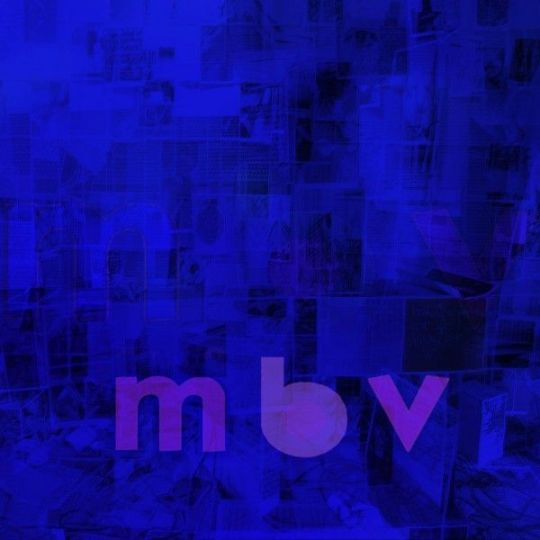
Wrote about mbv on a separate piece.
9. Earl Sweatshirt — Some Rap Songs

Earl Sweatshirt’s Some Rap Songs is a record of mending and therapy. At the beginning of the decade, rap fans saw the 16 year old prodigy create the most technical and distinctive raps unheard of at that time. Yes, a lot of it was jarring and immature, but the potential was there. While debut mixtape EARL was a teaser and an introduction to his greatness, Doris was his reclamation to the rap game after a period of silence in Samoa. I Don’t Like Shit, I Don’t Go Outside in turn spoke for itself. Its morose disposition then made its way onto Some Rap Songs; not quite his masterpiece, but an accomplished period piece nonetheless. As one of the most highly acclaimed rappers in the world today, Earl spills his guts out on this diaristic tape about his relationship with his father and the emotional exhaustion coming from trying to amend it. On “Red Water,” he repeats the same 8 bars on loop as if caught in a recurring dream. “Papa called me chief / gotta keep it brief / locked and loaded I can see you lyin’ through your teeth” he raps in a fugue state, as if coming to the realization that his father was only there for those momentary times of convenience. It’s always difficult to write something that includes family and loved ones. There’s a sense of vulnerability you have to divulge in as well as a catharsis that fulfills one’s desire to let go of one’s agony. The beats on Some Rap Songs run on loose kaleidoscopic loops, production that Earl has mastered rapping over as his idiosyncrasies in his bars do best when complementing them. Thanks to the influence of his buddies Mike and Medhane, he’s learned to channel his eccentric flows onto those beats. “Riot” closes the record with the sentimental instrumental sampling jazz legend, and uncle, Hugh Masekela. It’s feels like a proper ending to Earl’s chronicle, but the events that have transpired will always be apart of his life. At the end of it all, Some Rap Songs will remain forever a tombstone of his anguish.
8. The Spirit of the Beehive — Hypnic Jerks
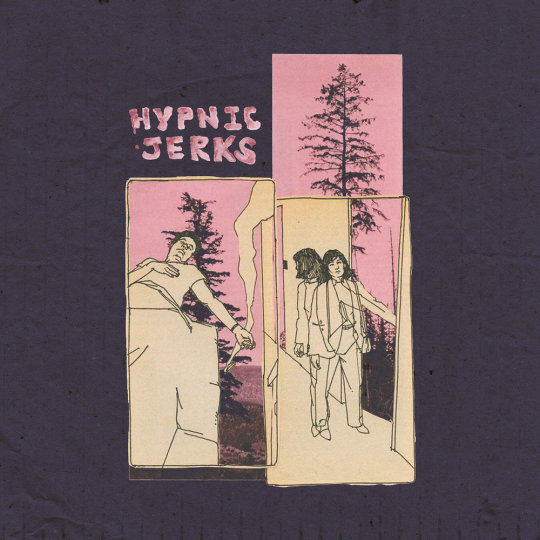
There’s no other dream pop record this decade that could top this almost-perfect album. The hushed vocalizations of Zach Schwartz and Rivka Ravede offer a quiet intimacy in the dreamscape that is Hypnic Jerks. The title in itself lends to the idea of being half asleep and half awake — to be in an altered state where the real and surreal are just two sides of the same coin. Tracks like “poly swim” and “it’s gonna find you” entrance you into that state of unconscious, while tracks like “can i receive the contact?” and “hypnic jerks” make an effort to wake you up from the sublime. Field recordings filter in and out between tracks, as if you were hallucinating the whole time. It’s when “nail i couldn’t bite” and “(without you) in my pocket” play out that you realize it doesn’t matter what state you lie in. Their lucid pop constructions reward repeated listens to the point of obsession in a somnambulant state. The record’s lack of acclaim only makes it feel like you’re in on a hidden secret. To this day, I am completely spellbound to its sorcery and have yet to unlock its mysteries.
7. Iceage — New Brigade

Back in elementary school, I listened to a lot of pop punk; the kind that was rapturously melodic yet cheesily done and overproduced (Think Blink 182 or All Time Low). Until I listened to New Brigade, I didn’t even realize what true punk music actually sounded like. Iceage was just fucking cool to me. Sure, they had the aesthetic, depicting bloody mosh pits and macabre rune art, but it was truly the music that broke into my spirit, shattering what I thought punk sounded like back in the day. I’d read pieces about their notorious live shows where they would play rapid 15-minute sets in the sunless recesses of Denmark, which only added to the band’s mystique. Upon listening to their debut, I felt musically fulfilled like never before. No more of the whiny, drawn out vocals from pop punk bands. Frontman Elias Bender Rønnenfelt had the kind of angsty drawl similar to Nick Cave’s when he played with The Birthday Party which offered a kind of obscene yet confident instability to his performance. Johan Surrballe Wieth and Jakob Tvilling Pless’s guitars have just the right amount of filth in them — an abrasive attack on your soul while Dan Kjær Nielsen’s drums are played propulsively in classic hardcore fashion — never meant decelerate. The record didn’t offer the tightest instrumental, but that was the point. Iceage have gone on to release tighter and more spectacular punk records consistently over the decade but their debut broke the ceiling of what to me punk could, and should, sound like. From the cathartic breakdown of “White Rune” to the triumphant “You’re Blessed,” New Brigade was the record that gave me that spark, the one that carried me to rotting heights.
6. Frank Ocean — Channel Orange
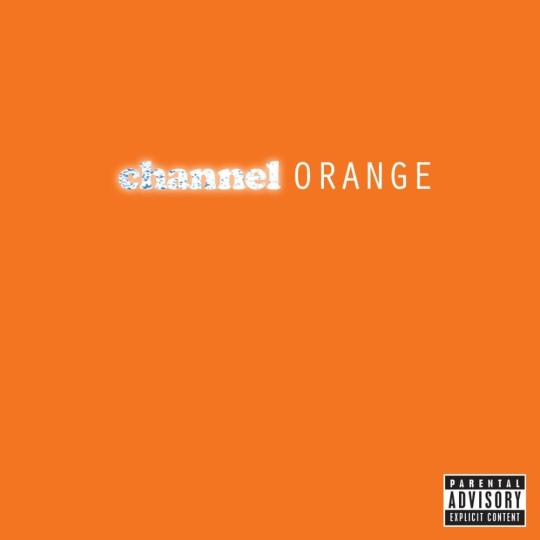
Channel Orange will always be a classic to my generation. From Grammy-nominated “Thinking’ Bout You” to the sweet and charming “Forrest Gump,” we surf through Frank’s psyche in smooth and effortless RnB. Frank Ocean’s vivid universe is one of vibrant summers and distant getaways. Its colourful motifs paint a pretty picture for us — pink skies, monks in moshpits, peaches and mangos, roofs of mansions, palm trees and pools, Majin Buu. Most people I know around my age know the lyrics to most of its tracks. They’re as infectious as any classic from the past decade. I still remember listening to “Sweet Life” by the beach with a friend before attending his concert on his first tour. Everything felt right in the world when he sang “so why see the world when you got the beach” as the waves crashed over the sand and the summer heat glistened over the ocean. During its release, he opened up to the world to reveal his love for another man in an affectionate Tumblr post. It gave us an appreciation into an artist’s vulnerable identity while breaking the door open for other artists to come out in their own way. Frank later released his masterpiece in Blonde/Endless and a plethora of brilliant singles from his radio show, but the stories and music from Channel Orange will remain forever timeless.
5. Solange — A Seat at the Table

“Fall in your ways / so you can crumble / fall in your ways / so you can wake up and rise” sings Solange, on the introduction to her restorative album A Seat at the Table. They’re words I try to tell myself in times of darkness. Solange just has that ability to let anybody express themselves through her music, to meditate on life’s injustices and pitfalls. It’s okay to be mad; it’s okay to rest and take care of yourself as much as you need to. We just have to rely on each other to get back into the fight. It feels like a lot of my favourite records from the past decade are imbued with themes of darkness and isolation. Fortunately, I still have Solange to let myself vent out those frustrations. Whether it’s the strings on the beginning of “Cranes in the Sky” that remind me to slow down or the horns projected behind Master P’s stoic orations that fuel my determination to keep afloat, A Seat at the Table plays like an instruction manual for self-care, black empowerment, and righteous activism. It’s consoling to know that I’m not alone in distracting myself from everything that’s wrong with the world today. 2016 was such an appropriate time for this record to be released. Solange gave us hope, grace, stoicism, and the ability to heal and recharge. A Seat at the Table may be a personal record to Solange, but as she sings on “F.U.B.U.,” this shit is for us.
4. Chance the Rapper — Acid Rap
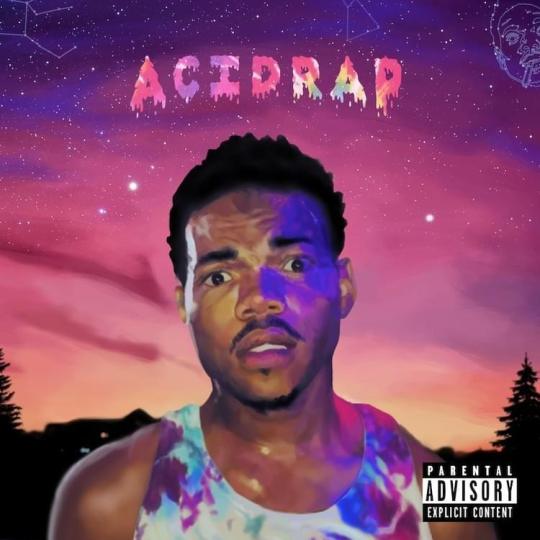
It’s odd to say that my favourite rap record of the decade comes in the form of pop rap album Acid Rap. In making this list, I thought about the obvious greats in My Beautiful Dark Twisted Fantasy or Good Kid, M.A.A.D. City. In the end, Chance’s second mixtape brought me more joy than any of those records did. It gave me the cringiest but most pleasurable musical moments with the homies singing along to tracks like “Cocoa Butter Kisses” and “Pusha Man.” Releasing it independently and as a free download, Chance’s spoken-word idiosyncrasies reveal themselves as classic pop rap gems by the end of the decade. Chance’s whole thing was just about pure positivity and having fun. The era of albums I could compare to it was during the release of Kanye’s College Dropout and Late Registration, a time when Kanye (sort of) envisioned the anti-stereotype in rappers, countering the machismo and toxic masculinity found in a lot of hip-hop now and back then (RIP old Kanye). Chance didn’t care about getting bitches or getting money. He just wanted to do drugs with his friends — to trip out on acid and go on a spiritual journey with all of us. Hidden beneath the positivity, Chance still creeps in a dash of realism and humanity on tracks like “Paranoia,” illustrating the life of gang-banging in his hometown of Chicago. It’s the earnestness in his raps that always pulls me back, the flourishes of piano when he raps “I lean back then spark my shit / I turn up I talk my shit / hope you love all my shit / I hope you love all my shit / IGH.” It turns out, as he declares on the outro, Everything’s Good.
3. Alex G — DSU
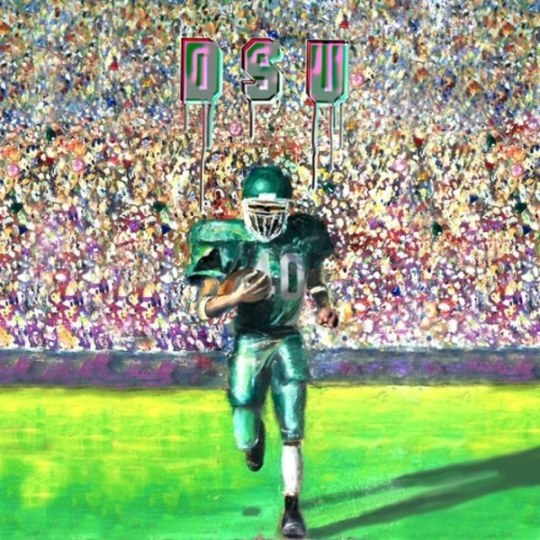
On DSU, time stops. The cult of Alex G is now cemented in indie rock lore at the end of the decade with eight albums full of hooks, dreams, and shattered spirits. DSU was the first record I listened to by Alex G, and remains my favourite by his despite him going on to release better conceptual records in Rocket and House of Sugar. No track can be skipped or listened to passively. With most of them springing under the 2–3 minute mark, ideas flow in and out without direction but coalesce into an impressionistic and breathtaking work of art. Hints of Elliott Smith and Isaac Brock echo in the duality of harsh guitar distortion and melodious pop hooks. Guitar feedback never felt so comforting as it colours the magnificence of Alex G’s composition. There’s a kind of deep melancholy in each track despite the ambiguous surrealism lyrics, a perfect winter record to listen to alone in your room or walk through the piles of snow in the night. Its murky yet lush production somehow reaches out to you, helps you drown in its depths and remain there for its 37 minutes. Whether it’s “Skipper” fully attuning you to its hushed presence, or the entrancing opener of “After Ur Gone,” I just feel like I want to close my eyes and immerse myself in there for as long as it allows me to.
2. Frank Ocean — Blonde
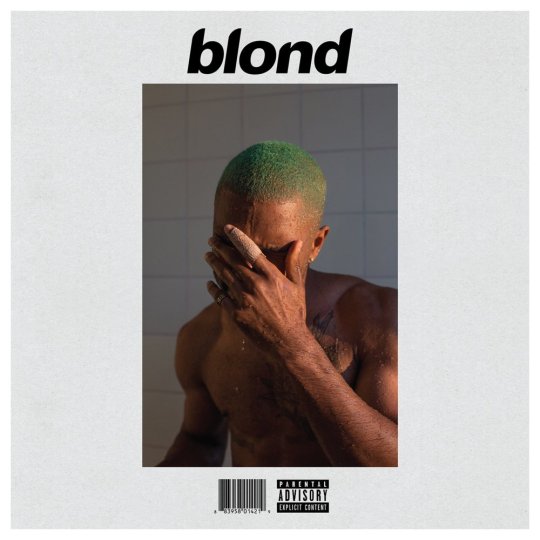
Frank Ocean’s Blonde arrived as a gift from the heavens. For five years, my friends and I have joked and memed about when the new Frank was coming out — whether it was even ever going to come out. Years after its release, it has evolved into the masterpiece that I’ve always wanted him to create. When Endless came out, I felt somewhat disappointed at the material — although later served as the perfect complement to Blonde — because of its lack of sensual pieces similar to those on Channel Orange’s effortless RnB and the latter record’s penchant for easy sing-alongs. Blonde in turn revealed a similar mood: the spacious vapour that fogged up behind Ocean’s intimate croon, the volatility in his voice that permeated your soul — it felt like an emotional load that was difficult to bare, yet something necessary that had to be experienced. I was just getting into my first intimate relationship when Blonde came out, and it’s made me realize how much I wanted to make that person happy, and that I couldn’t take any relationship I had for granted. I felt heavy after listening to this record. The sadboi hours memes ring true to its emotional weight. I would flutter to the arpeggios of “Ivy” as Frank sings “I thought that I was dreamin’ when you said you love me,” bop to the duality of “Nights,” and shed a tear to the wistfulness of “Godspeed.” I wonder how much shit Frank had to go through to even get any of these songs on tape. It’s okay. I like to think think that by the end of it all, Blonde was the catharsis he needed to spill his heart out.
1. Tame Impala — Lonerism
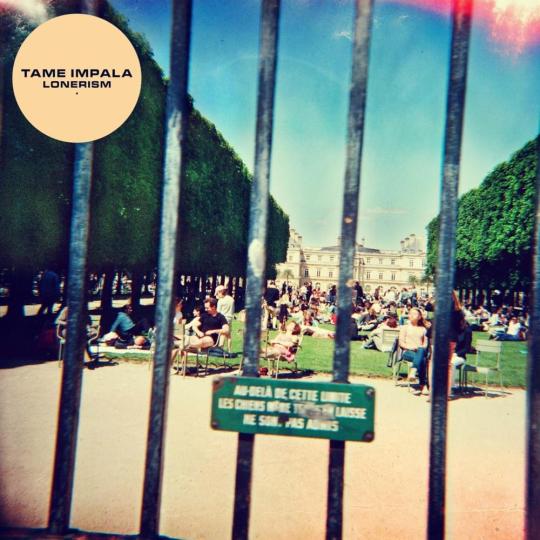
At the end of the decade, seeing Kevin Parker as one of the most highly-touted producers and songwriters in pop music would be an observation if you had asked me a decade ago, when Tame Impala’s first record Innerspeaker — an expansive work of art that recalled 60’s guitar psychedelia — first came out. On Lonerism, Parker’s music evolved into something even more seismic and innovative in scope. As the name suggests, Lonerism is a product of disaffection, self-defeat, and isolation. I’d imagine it was as fulfilling to other music fans of a type to detach from the world and just get lost in another’s. There’s a part on “Keep on Lying” where an endless guitar solo is played in the midst of a dinner party being played out; that feeling of getting dragged to a party when you were just a kid but just wanted to pop your headphones on and refuse to interact with anybody. According to Parker, he put in the sample to make the listener feel even more alienated. It’s a powerful feeling that lets anyone listening to the record in on that vulnerable sensation. In spite of that, tracks like “Apocalypse Dreams” and “Elephant” still give us astonishing psych rock bangers while pop gems “Music to Walk Home By” and “Feels like We Only Go Backwards” demonstrate Parker’s guitar pedal gymnastics over vibrant hooks. Although Currents has skyrocketed him into the fame and acclaim that he undoubtedly deserves, this record will always be his opus in my heart. I’ve daydreamed enough times to the music where its world has settled into my subconscious. It’s a world that comes from genius, but it’s also a world that invites you in to escape from the idea of Lonerism itself, to have something shared with you in solitude.
#top 10 albums#tame impala#frank ocean#alex g#chance the rapper#solange#iceage#the spirit of the beehive#My Bloody Valentine#album review#lists#earl sweatshirt
11 notes
·
View notes
Text
Events 2.23 (before 1940)
303 – Roman emperor Diocletian orders the destruction of the Christian church in Nicomedia, beginning eight years of Diocletianic Persecution. 532 – Byzantine emperor Justinian I lays the foundation stone of a new Orthodox Christian basilica in Constantinople – the Hagia Sophia. 628 – Khosrow II, last Sasanian shah of Iran, is overthrown. 705 – Empress Wu Zetian abdicates the throne, restoring the Tang dynasty. 1455 – Traditionally the date of publication of the Gutenberg Bible, the first Western book printed with movable type. 1763 – Berbice slave uprising in Guyana: The first major slave revolt in South America. 1778 – American Revolutionary War: Baron von Steuben arrives at Valley Forge, Pennsylvania, to help train the Continental Army. 1820 – Cato Street Conspiracy: A plot to murder all the British cabinet ministers is exposed and the conspirators arrested. 1836 – Texas Revolution: The Siege of the Alamo (prelude to the Battle of the Alamo) begins in San Antonio, Texas. 1847 – Mexican–American War: Battle of Buena Vista: In Mexico, American troops under future president General Zachary Taylor defeat Mexican General Antonio López de Santa Anna. 1854 – The official independence of the Orange Free State, South Africa is declared. 1861 – President-elect Abraham Lincoln arrives secretly in Washington, D.C., after the thwarting of an alleged assassination plot in Baltimore, Maryland. 1870 – Reconstruction Era: Post-U.S. Civil War military control of Mississippi ends and it is readmitted to the Union. 1883 – Alabama becomes the first U.S. state to enact an anti-trust law. 1885 – Sino-French War: French Army gains an important victory in the Battle of Đồng Đăng in the Tonkin region of Vietnam. 1886 – Charles Martin Hall produced the first samples of aluminium from the electrolysis of aluminium oxide, after several years of intensive work. He was assisted in this project by his older sister, Julia Brainerd Hall. 1887 – The French Riviera is hit by a large earthquake, killing around 2,000. 1898 – Émile Zola is imprisoned in France after writing J'Accuse…!, a letter accusing the French government of antisemitism and wrongfully imprisoning Captain Alfred Dreyfus. 1900 – Second Boer War: During the Battle of the Tugela Heights, the first British attempt to take Hart's Hill fails. 1903 – Cuba leases Guantánamo Bay to the United States "in perpetuity". 1905 – Chicago attorney Paul Harris and three other businessmen meet for lunch to form the Rotary Club, the world's first service club. 1909 – The AEA Silver Dart makes the first powered flight in Canada and the British Empire. 1917 – First demonstrations in Saint Petersburg, Russia. The beginning of the February Revolution (March 8 in the Gregorian calendar). 1927 – U.S. President Calvin Coolidge signs a bill by Congress establishing the Federal Radio Commission (later replaced by the Federal Communications Commission) which was to regulate the use of radio frequencies in the United States. 1927 – German theoretical physicist Werner Heisenberg writes a letter to fellow physicist Wolfgang Pauli, in which he describes his uncertainty principle for the first time. 1934 – Leopold III becomes King of Belgium.
0 notes
Audio
I wrote a play! Lull was produced in January 2020 at Columbia University as part of an independent project on The Tempest, and was written and directed by me, Ruth Diamond. The cast of lovely voices you hear includes Alexandra Kapilian as Miranda, Kaleb Sells as Ferdinand, and Pia Deshpande reading the stage directions. Lull is set to be produced in Chicago by the Whiskey Radio Hour sometime in 2020 (whenever this pandemic ends and we can all go to shows again.)
Check out my other posts for more information about the play and its inspiration.
1 note
·
View note
Photo

playlist for ‘don’t turn away’ 002, on-air every sunday noon-two pm at 107.1 fm chirp radio.
listen on spotify - https://open.spotify.com/user/126045511/playlist/1fETSbMgjn7nwZFP3FWOL9
01. Positive Force - “We Got The Funk” (12″ Re-Edit) from We Got The Funk (Sanctuary) 02. Rainbow Team - “Bite The Apple” from A Song For You (Full Time) 03. Ibeyi - “Deathless” from Ash (XL) 04. Trio Da Kali & Kronos Quartet - “Samuel” from Ladilikan (World Circuit) 05. Dorothy Ashby - “Soul Vibrations” from Afro-Harping (Cadet) 06. Norman Connors - “Carlos II” from Love From The Sun (Buddah) 07. Jackie Shane - “You Are My Sunshine” from Any Other Way (Numero Group) 08. Buster Benton - “Catch Up With The World” from Catch Up With The World / Do As You Please (Twinight) 09. Knox Fortune - “24 Hours” from Paradise (Self-released) 10. Lawrence Rothman - “Wolves Still Cry” from The Book of Law (Downtown) 11. Mr. Fingers - “We Can Work It Out” from Introduction (MCA) 12. Lonnie Liston Smith & The Cosmic Echos - “Summer Days” from Expansions (Flying Dutchman) 13. Marta Acuna - “Dance, Dance, Dance” from Dance, Dance, Dance (P&P) 14. Phreek - “Everybody Loves A Good Thing” from Patrick Adams Presents Phreek (Atlantic) 15. Tricky - “When We Die” from Ununiform (False Idols) 16. Don Laka - “I Wanna Be Myself” from I Wanna Be Myself (Transistor) 17. Blue Hawaii - “No One Like You” from Tenderness (Arbutus) 18. The Cool Kids - “9:15PM” (feat. Jeremih) from Special Edition Grandmaster Deluxe (Propelr) 19. Sylvester - “I Need Somebody To Love Tonight” from Stars (Fantasy) 20. Spa Moans - “Wet Goddess” from Obedient Vibrations (Drop Medium) 21. Colleen - “One Warm Spark” from A flame my love, a frequency (Thrill Jockey) 22. Change - “A Lover's Holiday” from The Glow of Love (Warner Bros.) 23. Esqurita - “Dew Drop Inn” from Dew Drop Inn (Norton)
#chirp#chirp radio#chirpradio.org#chicago independent radio project#chicago#chicago music#music#radio#chicago radio#chicago playlist#playlist#local radio#local music#local#tumblrdj#dj#radiodj#djplaylist#soul#funk#jazz#electronic#house#chicago soul#rap#hiphop
2 notes
·
View notes
Text
7 Ones To Know if You’re a Fan of Anderson .Paak

Anderson .Paak has quickly become one of the most exciting and dynamic artists in the game right now. Blending hip-hop, R&B, funk, soul, gospel and jazz, .Paak has crafted a sound as distinguishable as the period in his name. The release of his first album, Venice back in 2014, first shined a light on his ability to combine nostalgic sonics with new-age influences. The album served as the first offering in a “beach series” trilogy the California native plans on releasing. The second installment, Malibu, was released in early 2016 and received critical acclaim from publications around the country.
Gearing up for the conclusion of the trilogy, Anderson .Paak visited Zane Lowe at Beats 1 Radio today to share his newest single, “Tint,” featuring none other than the living legend Kendrick Lamar. .Paak’s third album, Oxnard, is named after his hometown in California and is described by the multi-talented musician as, “the album I dreamed of making in high school.” Yet, .Paak would not be .Paak if he just stopped at Oxnard.
An artist of limitless creativity who constantly seeks to amaze and defy expectations, .Paak just surprise dropped a new album that features everyone from André 3000 to Smokey Robinson. Ventura, the latest soon-to-be acclaimed project from .Paak, sees him returning to his roots while still finding the space to explore newfound territory. And what better way to celebrate the release of Ventura than streaming it on repeat while discovering seven rising artists who may just follow in his footsteps?
Little Simz

First on our list of talented musicians is the gifted lyricist from North London, Little Simz. Her music is both versatile and intimate as she uses her ability to deliver introspective lyrics, airy melodies and instrumentation filled production. A true creative, Simz released eight mixtapes prior to her full-length album debut, A Curious Tale of Trials + Persons and her most recent album, Stillness in Wonderland. Quiet since the release of her last album, Simz recently resurfaced to share two new singles from what we presume is an upcoming album. The two tracks are focused around the U.K. vocalist’s confidence and her rightful claim to the throne.
Kweku Collins

Kweku Collins has a way with words. The poet/rapper/singer/producer from Evanston, Illinois, is operating in a lane all his own. A family background in music and deep seeded passion from a young age crafted Collins’ trademark concoction of hip-hop, R&B, and freeform poetry. His latest single, “ET,” evokes emotion from the moment you press play. Collins raps and sings over the subtle strumming of an acoustic guitar that helps shine a light on an unheard element of his artistry. The release of his critically acclaimed EP, Grey, in early 2017 and string of new singles have kept Kweku Collins in high demand.
youtube
Leven Kali

The talent that comes out of the Golden State of California never ceases to amaze me. And California’s most recent noteworthy artist, Leven Kali, is blurring the lines between R&B and funk, producing a sound that embodies his West Coast influences. Kali first made waves with the release of his independent project, 4102, back in July 2015. Kali would use the following two years to simultaneously work on his music and collaborate with artists like Playboi Carti, Topaz Jones, and Pink Slip. With currently four singles out, his most recent featuring Syd, Leven Kali appears to be gearing up for a proper debut.
youtube
Masego

Not many artists are as technically skilled in an array of instruments like Masego. The jack-of-all-trades musician from Newport News, Virginia, is the self-proclaimed king of trap house jazz. Masego released two 2016 EPs that showcased his ability to implement jazz elements into a litany of genres. His first, The Pink Polo EP, was a collaboration with electronic producer Medasin, his second and first solo EP, Loose Thoughts, was released a few months after. Masego reached international notoriety a year later for his live-looping collaboration with French instrumentalist FKJ for their song, “Tadow.” The video primed fans for Masego’s full-length album debut, Lady Lady, released in early September of 2018. The album is an ode to women around the world and the part they played in shaping the young musician’s life.
youtube
Jean Deaux

Anderson .Paak and Chicago based artist, Jean Deaux, share one impressive quality: their ability to navigate through complex pockets of production. Despite releasing her first single on DSP’s in mid-2017, Jean Deaux has been collaborating with the likes of Mick Jenkins, Isaiah Rashad, Saba and Smino since 2014. A representation of the company she keeps, Jean Deaux is offering rich, atmospheric vocals and off-center introspective lyrics about her trials and tribulations in the industry and life. Preparing for the release of her debut EP, Krash, Deaux is giving fans a glimpse into the highly anticipated project with her newest single, “Back 2 You.” The song showcases Deaux’s ability to match high energy production with an even more electric cadence. Needless to say, we are very excited to see what Jean Deaux has in store for us next.
Stimulator Jones

Anderson .Paak’s Stones Throw label mate, Stimulator Jones, is a part of the genre-bending community of artist determined to push musical boundaries forward. Exposed to the entire spectrum of musical genres as a child, Jones quickly learned to play whatever instrument was in front of him. His debut project, Exotic Worlds and Masterful Treasures, is a direct reflection of his crusade. The album combs through various genres and time periods seamlessly blending and contrasting differing sonic elements. Stimulator Jones’ first offering is anything but stagnant, the dynamic debut leaves our curiosity rightfully piqued into what else Jones has to offer.
youtube
Saba

Chicago based MC, Saba is more than just a rapper or producer; he’s a storyteller. Painting vivid images with words, Saba has been one of Chicago’s most prolific talents for some time. His contributions to Chance the Rapper’s Coloring Book and Noname’s Telefone marked the beginning of his ascension. He released his first album, Bucket List Project in 2016, receiving praise from his hometown as well as the entire country. Two years later Saba released, CARE FOR ME to much critical acclaim as it marked his most personal and emotional project to date. The project leans on Saba’s ability to conversate with listeners as he leads them through the difficult moments that have afflicted him the past couple of years.
youtube
#ones to know#anderson paak#kweku collins#saba#little simz#jean deaux#masego#leven kali#stimulator jones
26 notes
·
View notes
Photo
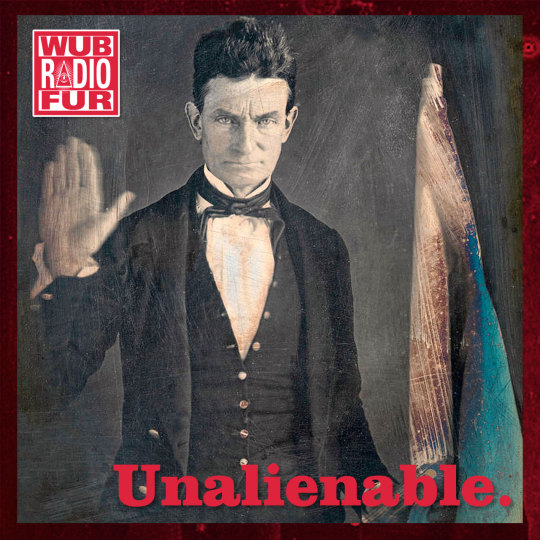
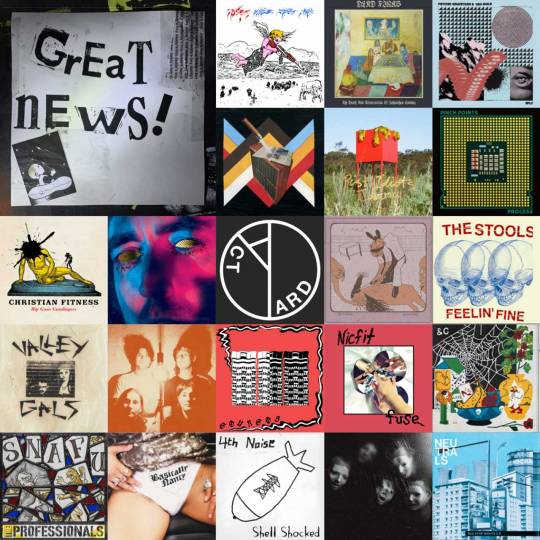
Unalienable.
It’s easy to declare our fundamental human rights unalienable, but rather more difficult to defeat the forces of reaction from whom those rights are under endless attack. On U.S. Independence Day weekend Wub-Fur Internet Radio salutes all those who fight to secure our rights with this eclectic mix of 22 rockin’ and rollicking punk (and punk adjacent) tunes from 2021 and 2022. Featuring the independent fighting musical spirits of Pinch Points, Parquet Courts, Yard Act, the Professionals, Dead Finks, Pist Idiots, A Place to Bury Strangers, the Stroppies, Nicfit, and 13 more bands from around the world who hold these truths to be self-evident.
Cover Art: The famous 1846 daguerrotype of American abolitionist John Brown by pioneering African-American (later Liberian) photographer Augustus Washington.
▶︎ Listen on Mixcloud (or scroll down to use an embedded player below)
Running Time: 59 minutes, 57 seconds
Tracklist
Baby (2:11) — Dead Finks | Berlin, Germany †
Neo-Lib Dreams (2:43) — Soursob | Glasgow, UK †
Working Class Losers (2:17) — Doc Flippers | Leipzig, Germany ◊
Broken (4:02) — A Place to Bury Strangers | Brooklyn, NY ◊
Black Widow Spider (2:48) — Parquet Courts | Brooklyn, NY †
School Project (3:47) — Basically Nancy | Savannah, GA ◊
Ripe (2:23) — Vacation | Cincinnati, OH †
Clocks (3:46) — DITZ | Brighton, UK ◊
Capital (3:02) — Pinch Points | Melbourne, Australia ◊
Ego / Ego (1:25) — Valley Gals | Western Massachusetts ◊
Stink (2:40) — Nicfit | Nagoya, Japan ◊
do u guys like music (2:19) — daddy's boy | Chicago, IL ◊
Tricks on Everything (2:32) — The Stroppies | Melbourne, Australia ◊
Idiocracy (2:08) — Pist Idiots | Sydney, Australia †
Heartburn (3:13) — The Professionals | London, UK †
Gary Borthwick Says (2:43) — neutrals | Oakland, CA ◊
The Overload (3:15) — Yard Act | Leeds, UK ◊
What Have We Become? (3:42) — USA Nails | UK ◊
The Word (3:01) — 4th Noise | Sweden †
Half Track Mind (1:09) — The Stools | Detroit, MI †
how do you schlep? (2:43) — christian fitness | Cardiff, UK †
Under The Gun (2:07) — Toner | Oakland, CA †
All tracks released 2021 † or 2022 ◊.
✋ ⚫️ ✋ ⚫️ ✋ ⚫️ ✋ ⚫️ ✋ ⚫️ ✋ ⚫️ ✋ ⚫️ ✋
Embedded Mixcloud Player
1 note
·
View note